How To Make A Potager Garden: create a beautiful French kitchen garden with flowers, herbs, and vegetables in raised beds, and garden she shed.

Jump to:
I'm so excited to share exactly how we made over our under-used side yard to create this beautiful potager garden. It's been a labour of love and created the most wonderful space.
Before
We've had a pretty little veggie patch in our side yard ever since we first moved into this house about 13 years ago. But in the last few years my youngest daughter has taken an interest in gardening and growing cut flowers. And in the last few years I've been trying to grow a pumpkin patch -without too much success. So this year, with us all being home, it seemed like the perfect time to redo the small space in our side yard and expand our space to plant.

The side yard had a few good features. Our yard is a pie shaped lot, and the side yard feels almost walled in my our house, and the privacy fence beside the neighbours house. This area also has the added advantage of full sun in the area in many areas. We also had a really cute little arbour and gate with roses on it that we rarely enjoyed. The existing small vegetable plot had a really nice path made of cobblestone bricks we could re-use, and a cute focal point of a sundial. Other than that there were a few overgrown and largely ignored beds and that's it. The space is a bit of an awkward shape, and the grass was tricky to cut because of the veggie patch in the middle.
The Garden Makeover
I knew I wanted to add raised beds to the area for a mix of vegetables, herbs, and flowers. I also decided on pea gravel paths, a garden shed and a seating area. With the corona virus this spring and all of us working and schooling from home, a family project seemed like a very good idea.
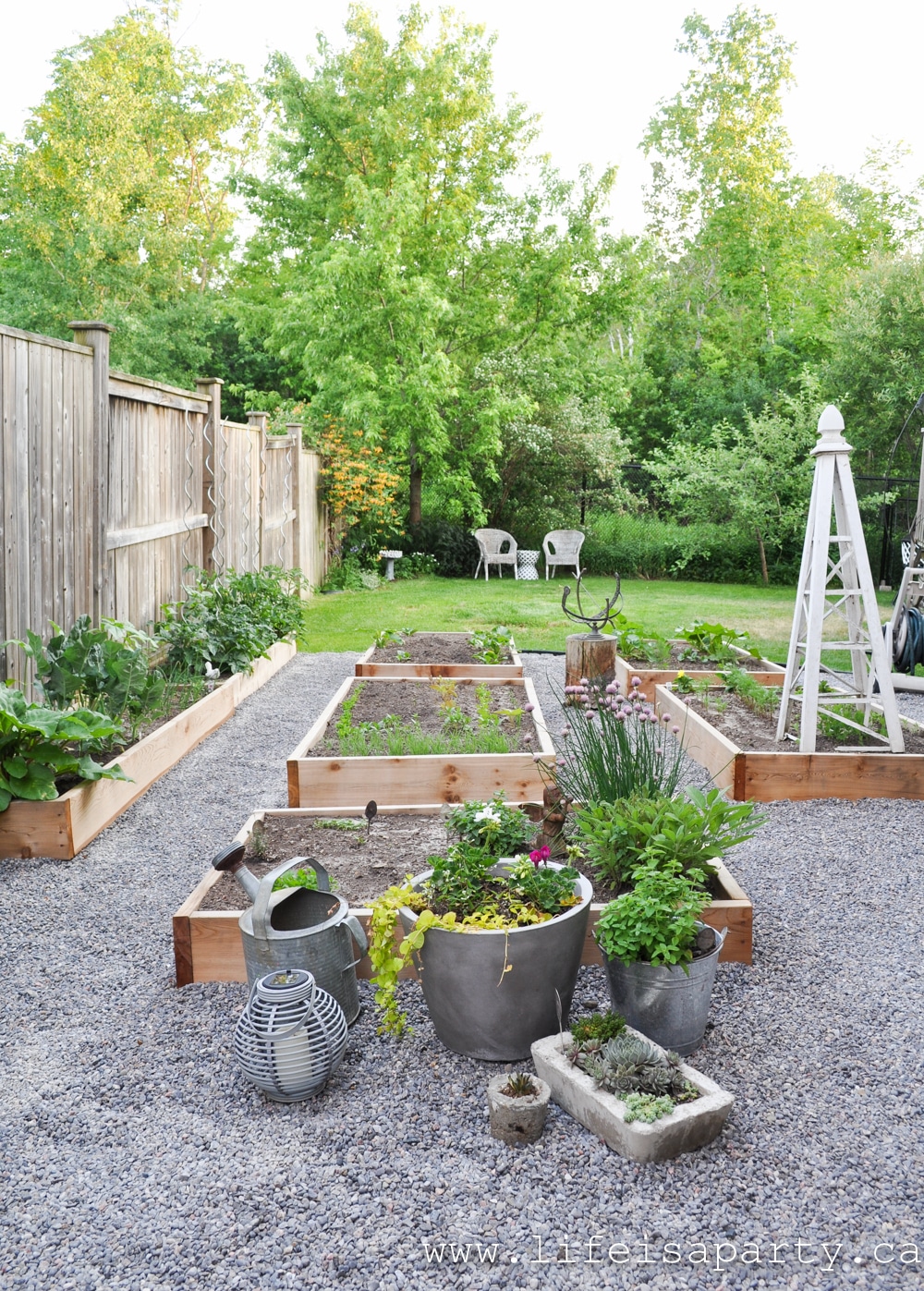
Planning On Paper
We put a lot of planning into this project. The first thing I started with was measuring our side yard and transferring it to graph paper. We cut out different sizes of raised beds to experiment with fitting the most in and their placement and also a shed and a seating area. It really helped to plan it out on paper first, and think about what we would plant in each bed. We ended up increasing the size of the shed slightly, and adjusting the bed placement a fair bit during the planning stage.
Focal Point and Raised Beds
Potager gardens often have a geometric design, which is often created by the raised beds. Ours is somewhat that way, with a focal point in the middle of the four raised beds. We also considered easy access, and how the paths would flow around the raised beds as part of the overall design. Many potager gardens use things like box hedges to define beds and or small stone walls. We went with cedar raised beds for most of ours, but did also include some perennial flower beds lined with cobblestones. The stones were some we had from the previous garden, and wanted to reuse.
Paths
You will also want to consider your paths when you're in the planning stage. Pavers are beautiful but expensive and more difficult to lay. Wood chips are probably the easiest way to create a path and an affordable option, but somewhat messy and at times hard to define. We opted for pea gravel and love it. It defines the area, is very easy to maintain, and was quite easy to lay. I also love the beautiful way it crunches underfoot when you walk on it. I will say though, it's difficult to push the lawn mower through to get from the front yard to the back.
What Is A Potager Garden?
As I was searching on-line for pretty vegetable gardens to inspire me, I came across the name potager garden quite a few times. It's a French word for a kitchen garden and it has the added bonus of making a garden that isn't just a functional space to grow vegetables, but also beautiful. This type of garden usually includes a pretty mix of vegetables, flowers, and herbs growing. That sounded like exactly what I wanted to create. Here's some of the things that a potager garden design usually includes:
- raised garden beds
- flowers, vegetables, and herbs
- paths
- a focal point
- the garden is usually enclosed by walls or fences
- it's close to the kitchen
- garden shed
- beautiful and functional
I've tried to incorporate all those elements in my new potager garden and I just love the results.
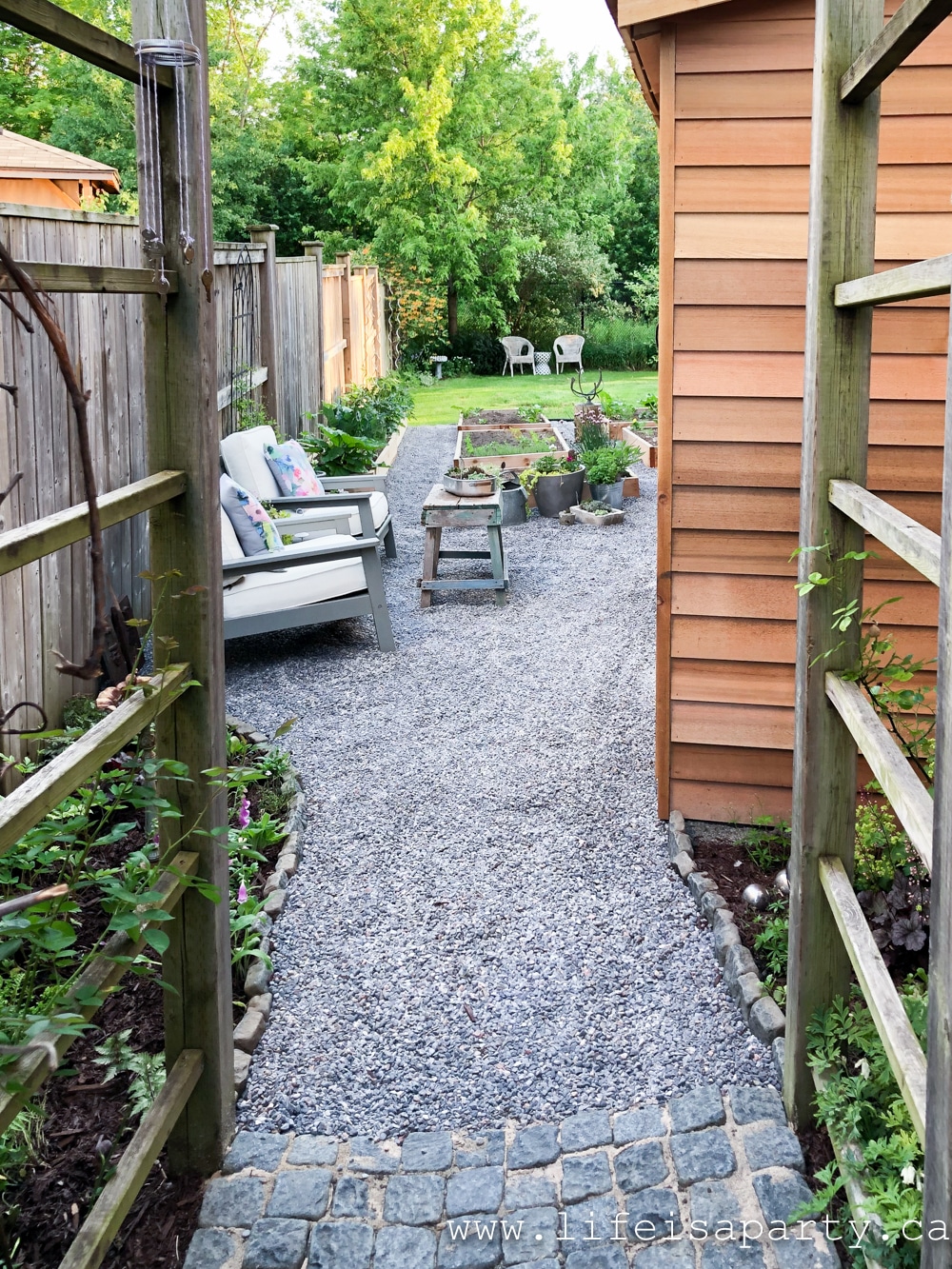
Raised Beds
Our first project was building the raised beds. We're not the DIY couple, and to be honest we were a little nervous about attempting it ourselves. We decided to give it a go, after some consulting with my brother-in-law who's a contractor and borrowing some tools for the project.
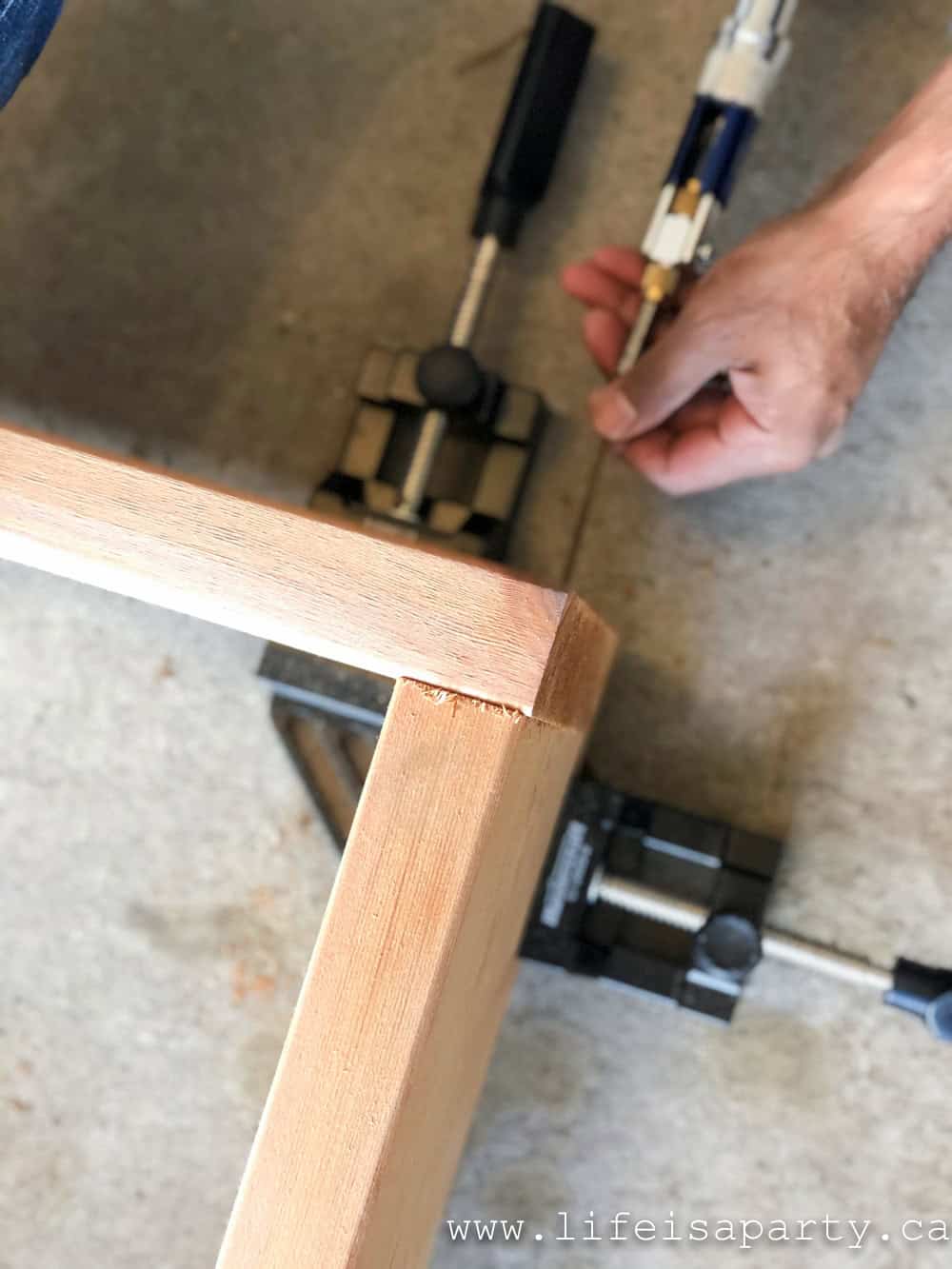
We did a fair bit of research on what materials to use, and how to construct them. There are lots of opinions on the subject. We ended up going with cedar. It's beautiful, it's long lasting, and works great for an edible garden because it's natural and untreated. The only drawback to cedar is it's the most costly. I'll be posting a tutorial on how to make the raised beds in the coming days. They were fairly easy to make, and turned out great.
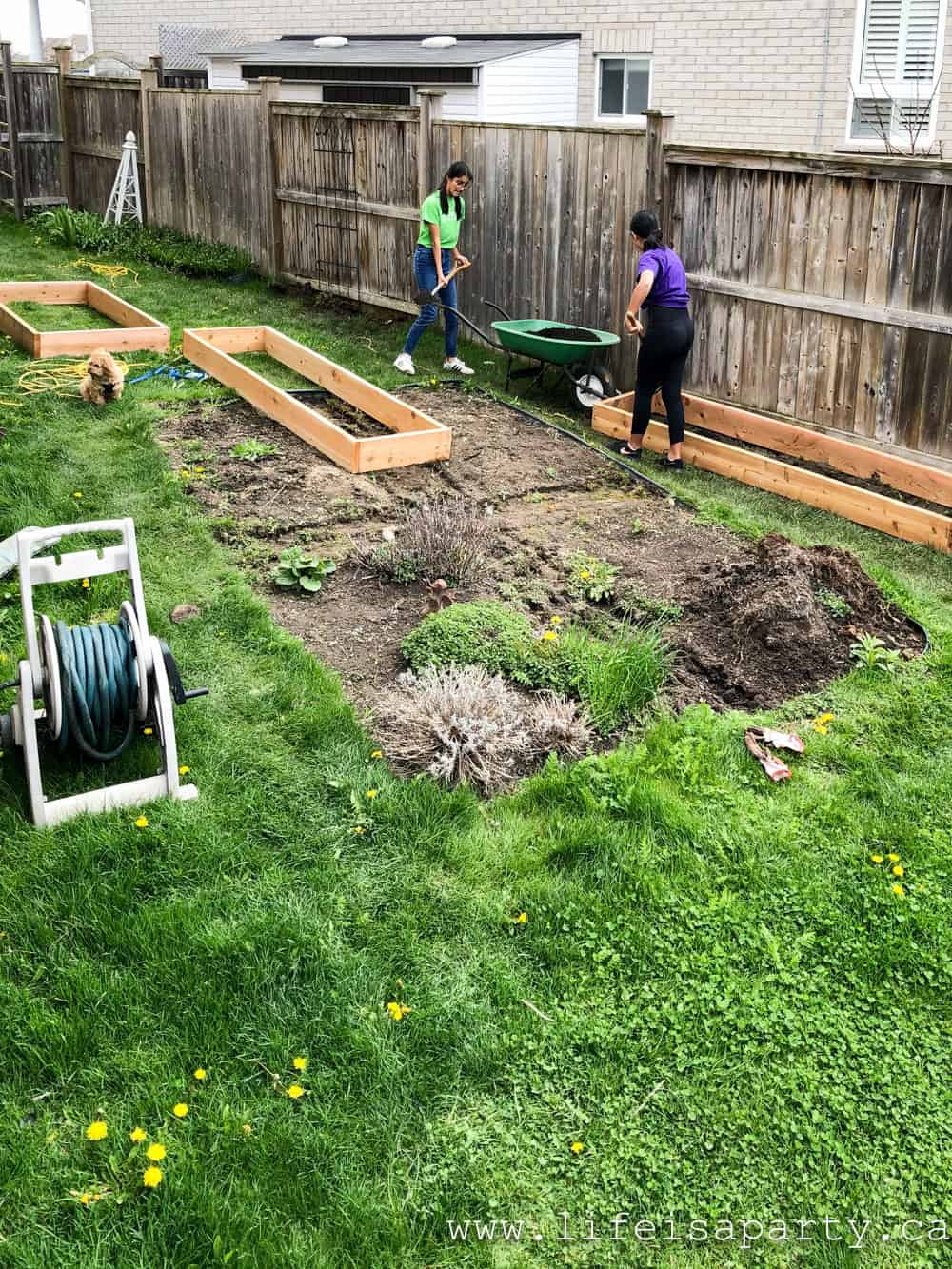
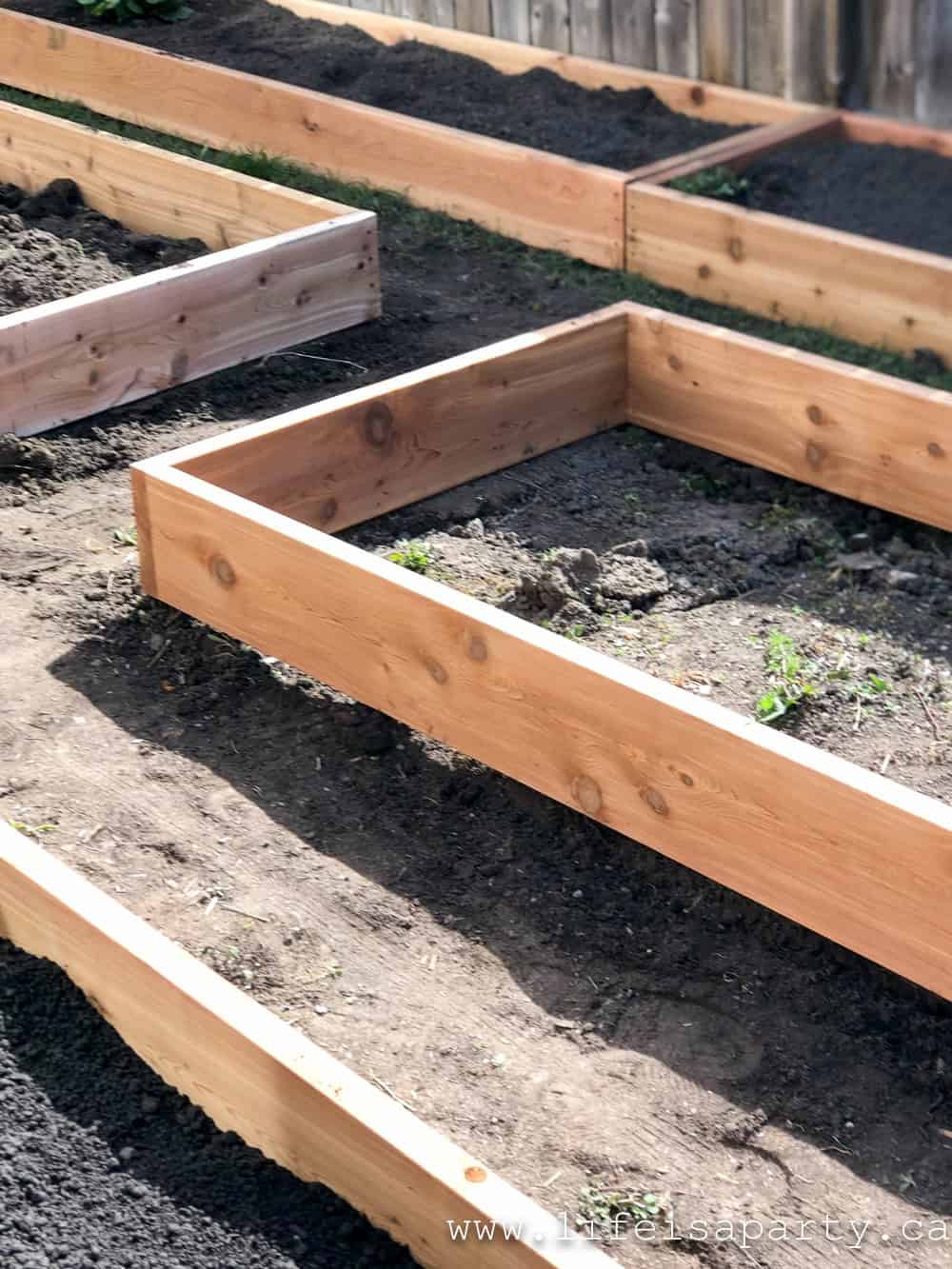
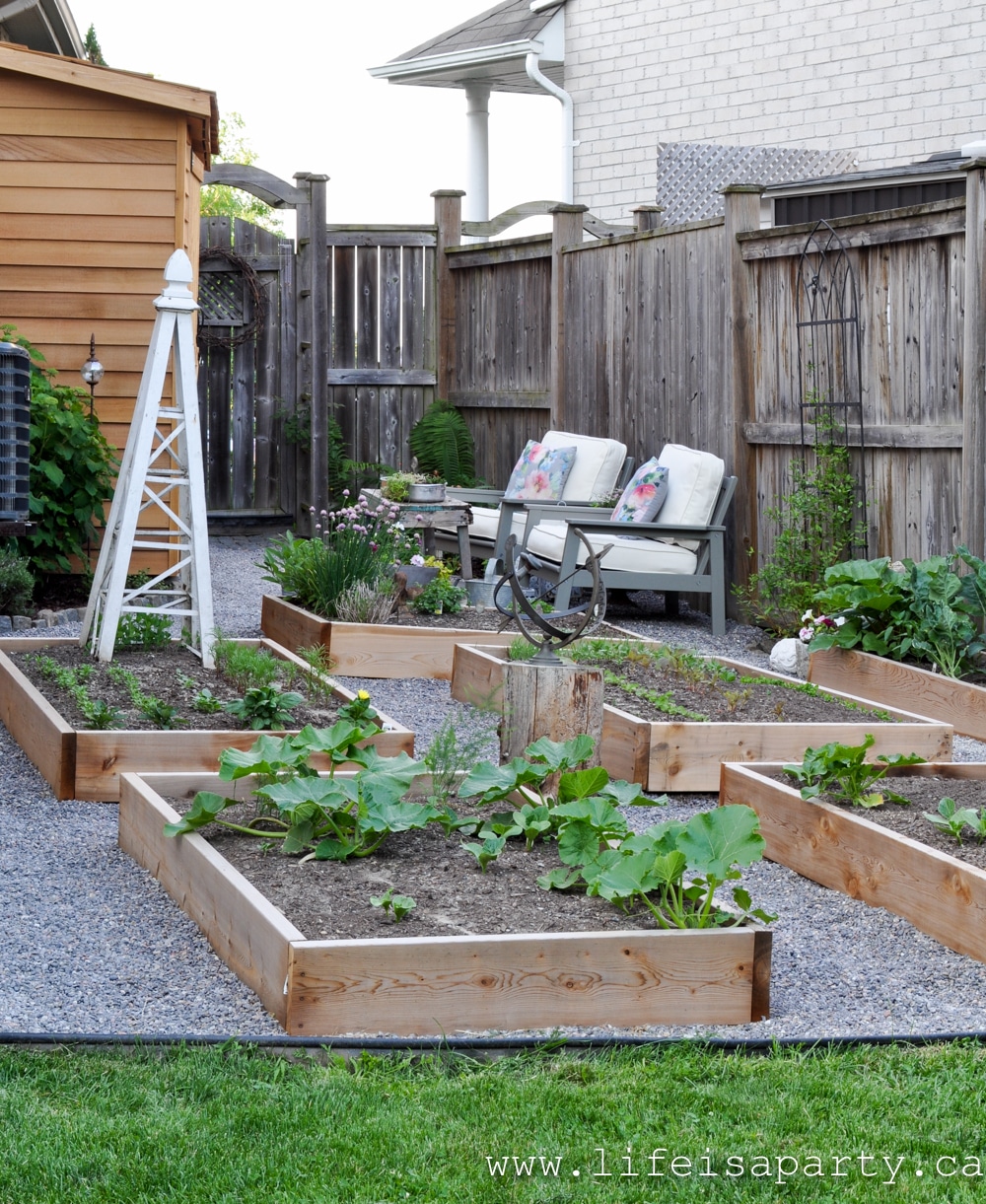
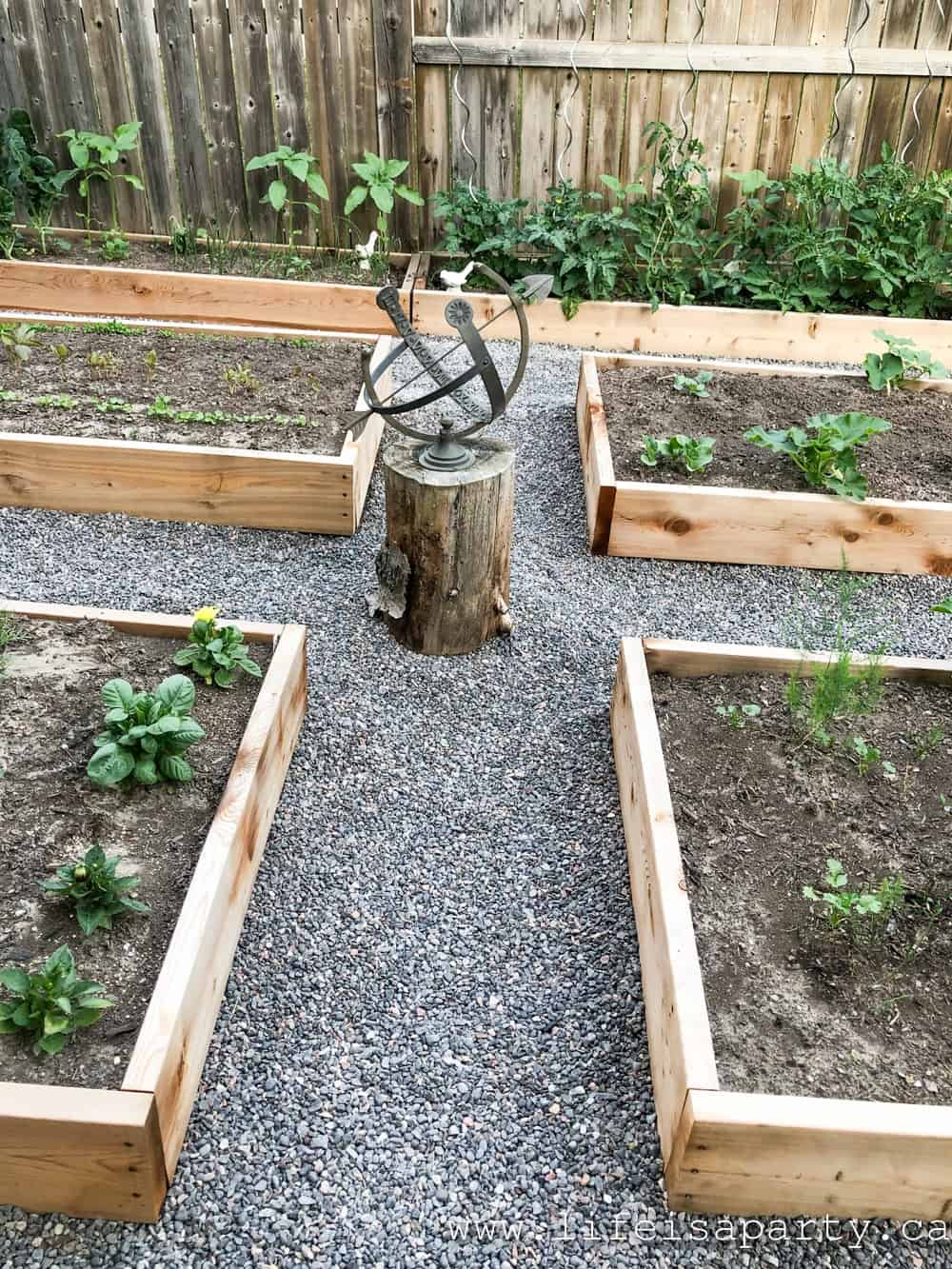
Flowers, Vegetables and Herbs
One of the hallmarks of a potager garden is mixing your fresh vegetables with fruit, flowers and herbs to create not just a functional space, but a really beautiful ornamental vegetable garden space. We loved this idea! We've filled different beds with different items.
Herb Garden
We have one bed designated for herbs where we planted a mixture of perennial herbs we moved from our old garden and herbs we grew from seed. I'm looking forward to enjoying fresh herbs all summer, and drying some for winter use too at the end of our growing season. I love how plants like the chives have edible flowers to enjoy as well.
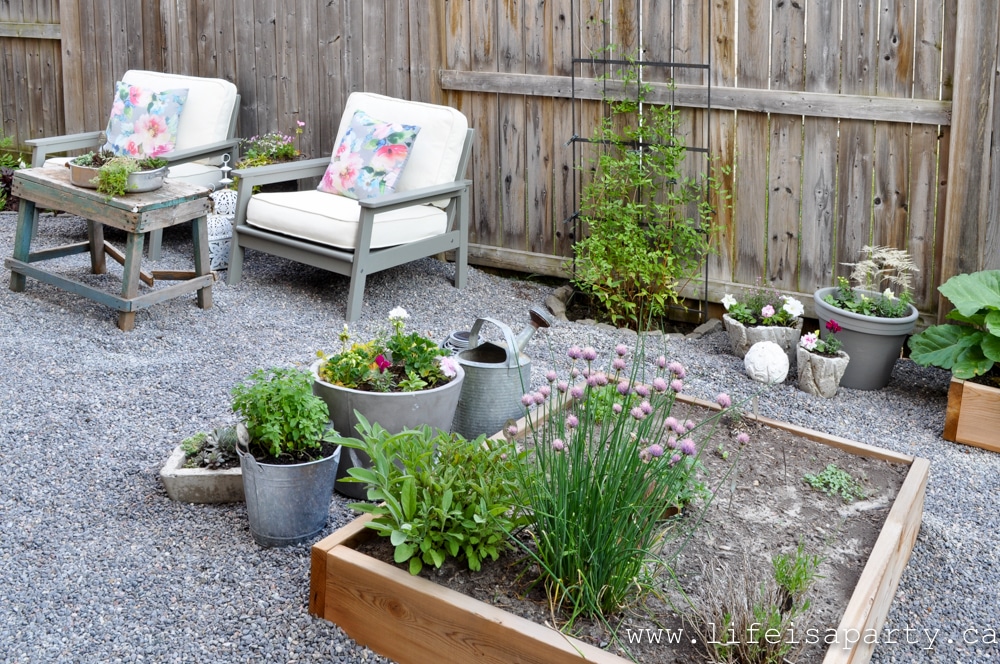
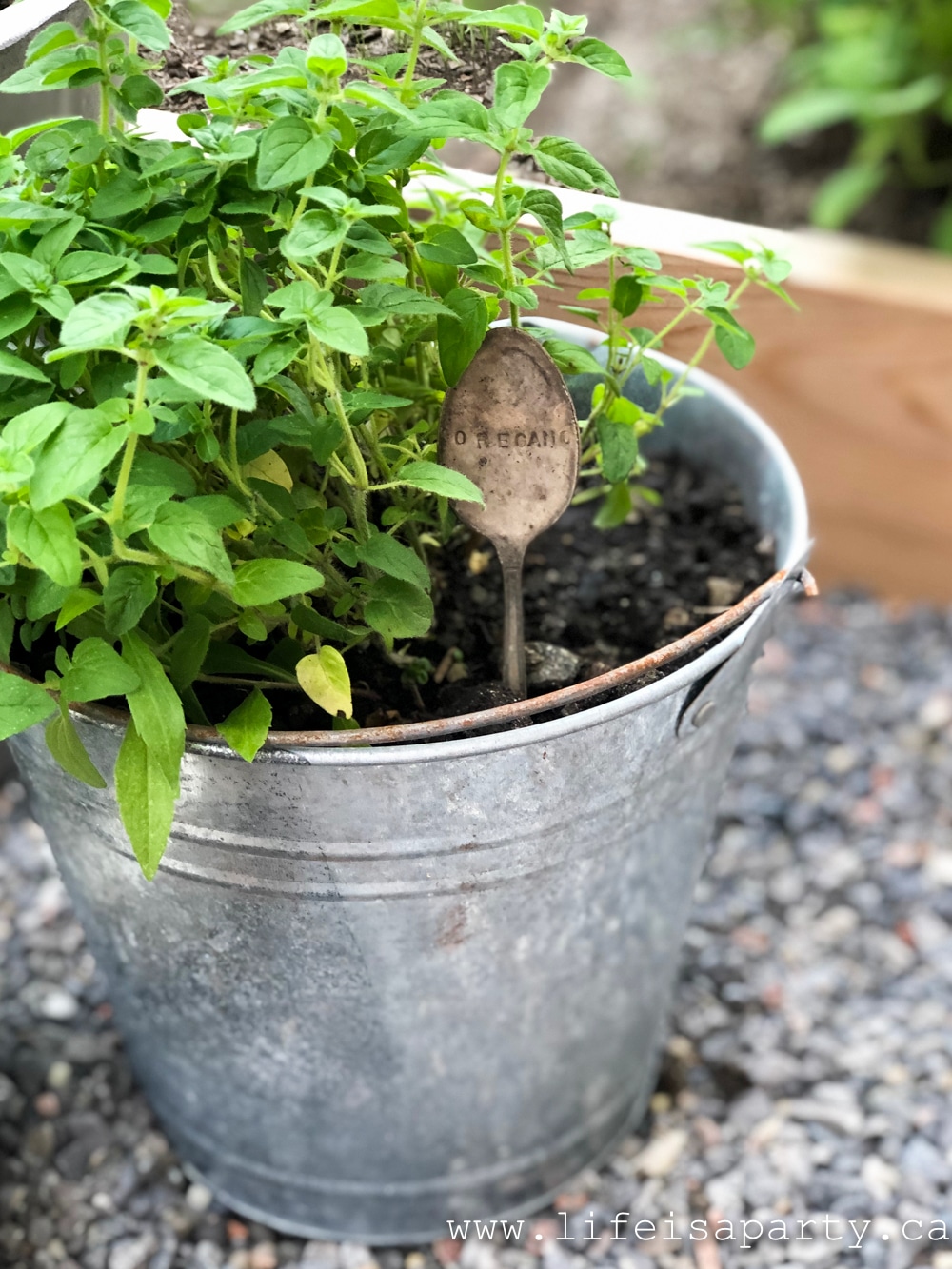
Vegetables
We designated 4 out of our 7 raised beds for fruit and veggies to grow some of our own food. Two of them are growing pumpkins! As a blogger I love using lots of different varieties of pumpkins in the fall, and they're sometimes hard to find, and can end up being quite expensive. The year before last I tried saving some seeds from my favourites in the fall and planting them in the spring. We made a few mistakes last year, but learned lots of lessons. This year we're hoping for a great pumpkin patch with different white, green, grey, and blue pumpkins. We'll see how it goes.
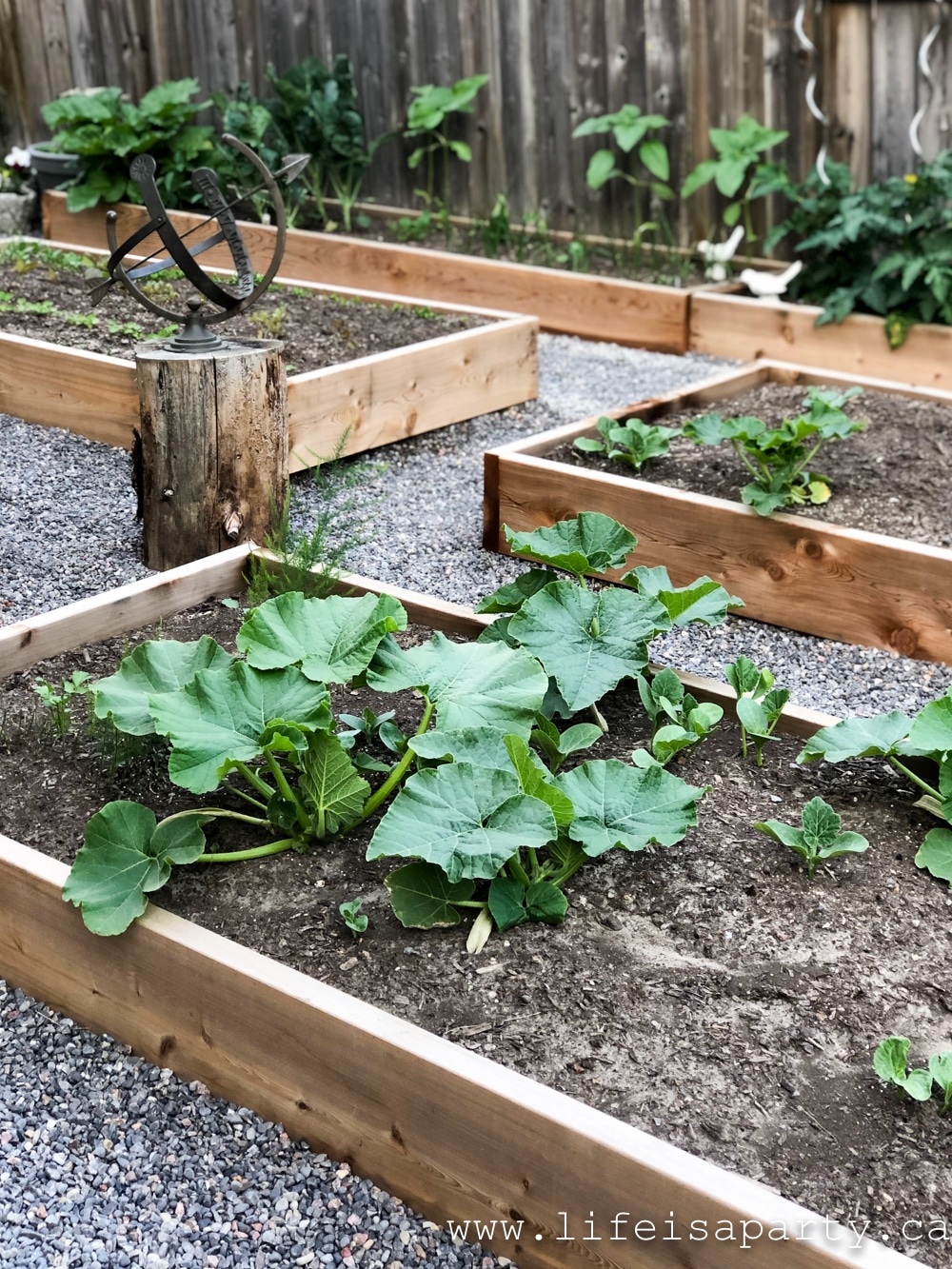
In the additional veggie beds we're growing tomatoes, onions, peppers, broccoli, asparagus, and rhubarb, with a few sunflowers along the back for fun. It's such a great way to combine more ornamental plants like the pumpkins and sunflowers with annual vegetables. And we even have some perennial fruits and vegetables in our potager kitchen garden with our rhubarb and asparagus, which come back and get better and better each year.
There are no set rules with a traditional potager garden, but we've grown our veggies in lines of plants or traditional rows. You use planting patterns if you want a more formal look. We've kept ours quite informal.
Fruit
We did not really have room for many fruit plants in our small space. Small fruit trees are often included in a French garden. Things like dwarf apple trees are gorgeous full of blossoms in early spring and producing apples in the fall. You won't want to include large trees because they'd block too much light. We do have a small apple tree at the end of our lawn and love it. Any fruit trees or berry bushes would make a great addition to a potager garden, and we're thinking of adding in some strawberries. These perennial plants come back year after year, so you need to think about where you want them to stay for a long time.
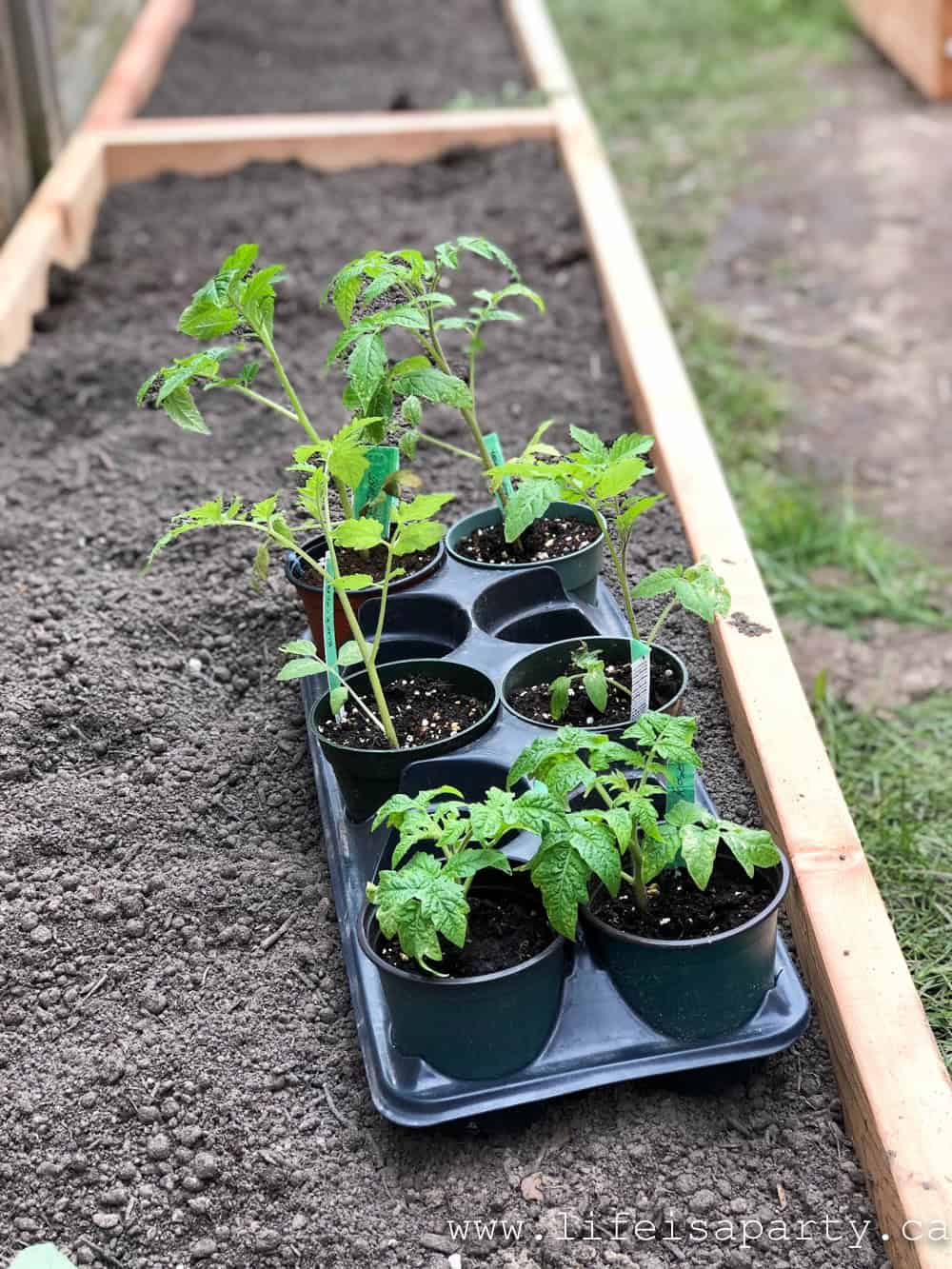
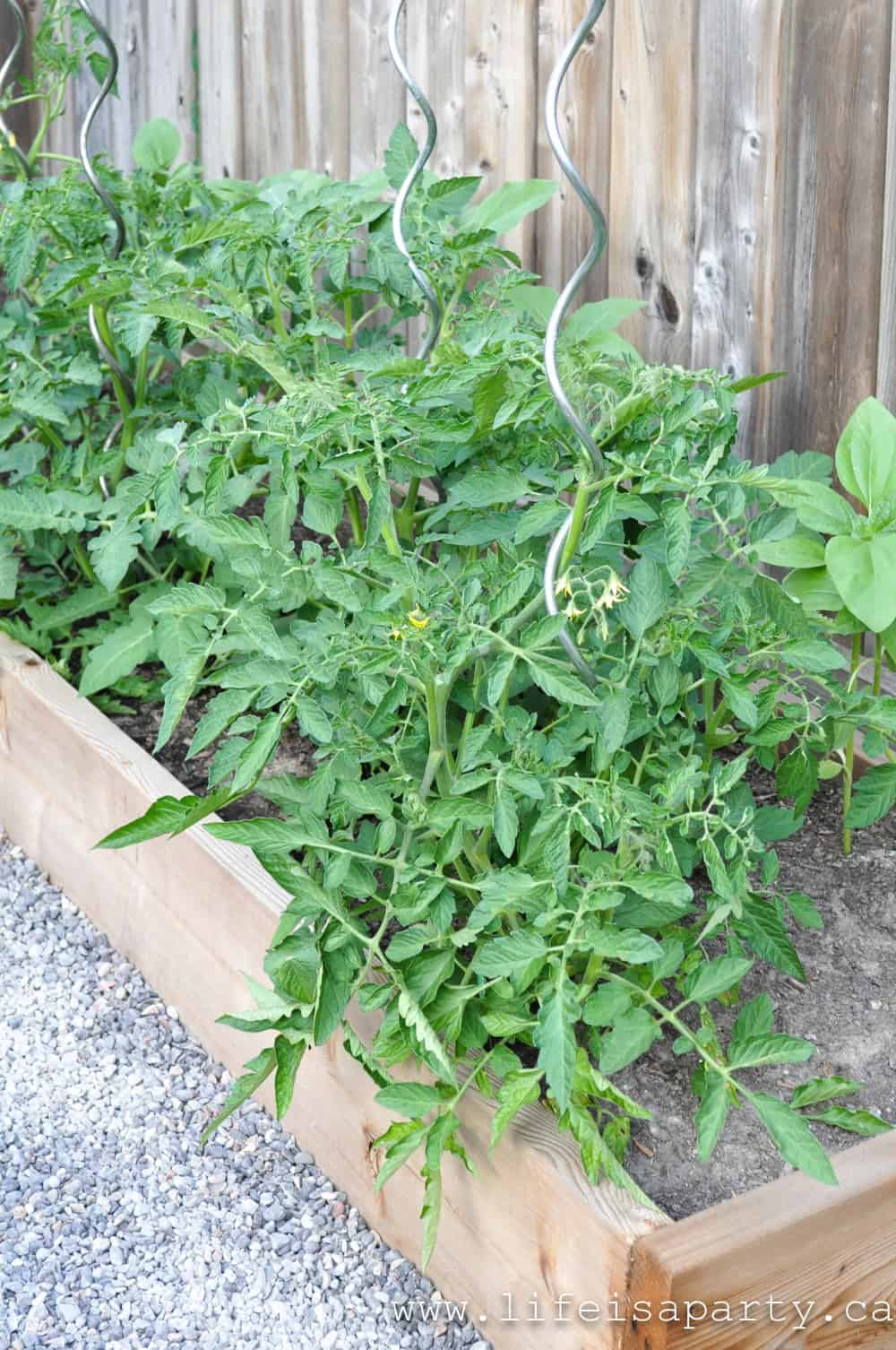
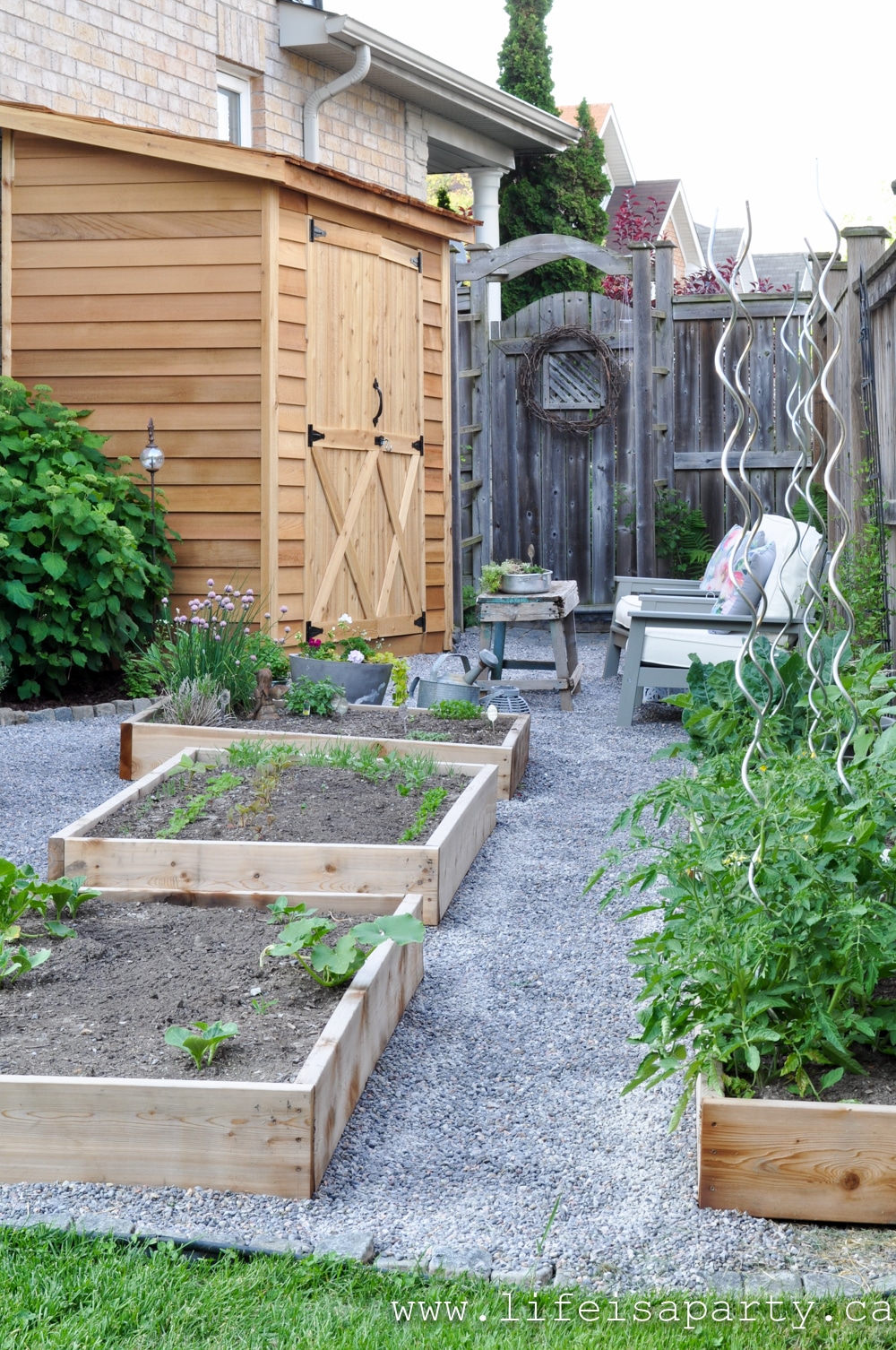
Flowers
We've also planted two beds with flowers for cutting. We included lots of old fashioned favourites with an English country garden feel. The flowers are grown from seed, and we are hoping to be able to create lots of beautiful flower bouquets later this summer. We sowed directly in soil in the spring, which is partly why our very first project of this garden makeover was to get the raised beds built and filled with soil so that the seeds could get started while we worked finishing the rest of the space.

Everything is up and starting to fill out now and we couldn't be happier with how it's all growing.
Paths
I love pea gravel. I've used it over in my white garden to make a seating area, and knew I wanted to include it in this space too. We've used it here to create paths between all the raised garden beds and a seating area too. It's quite easy to lay.
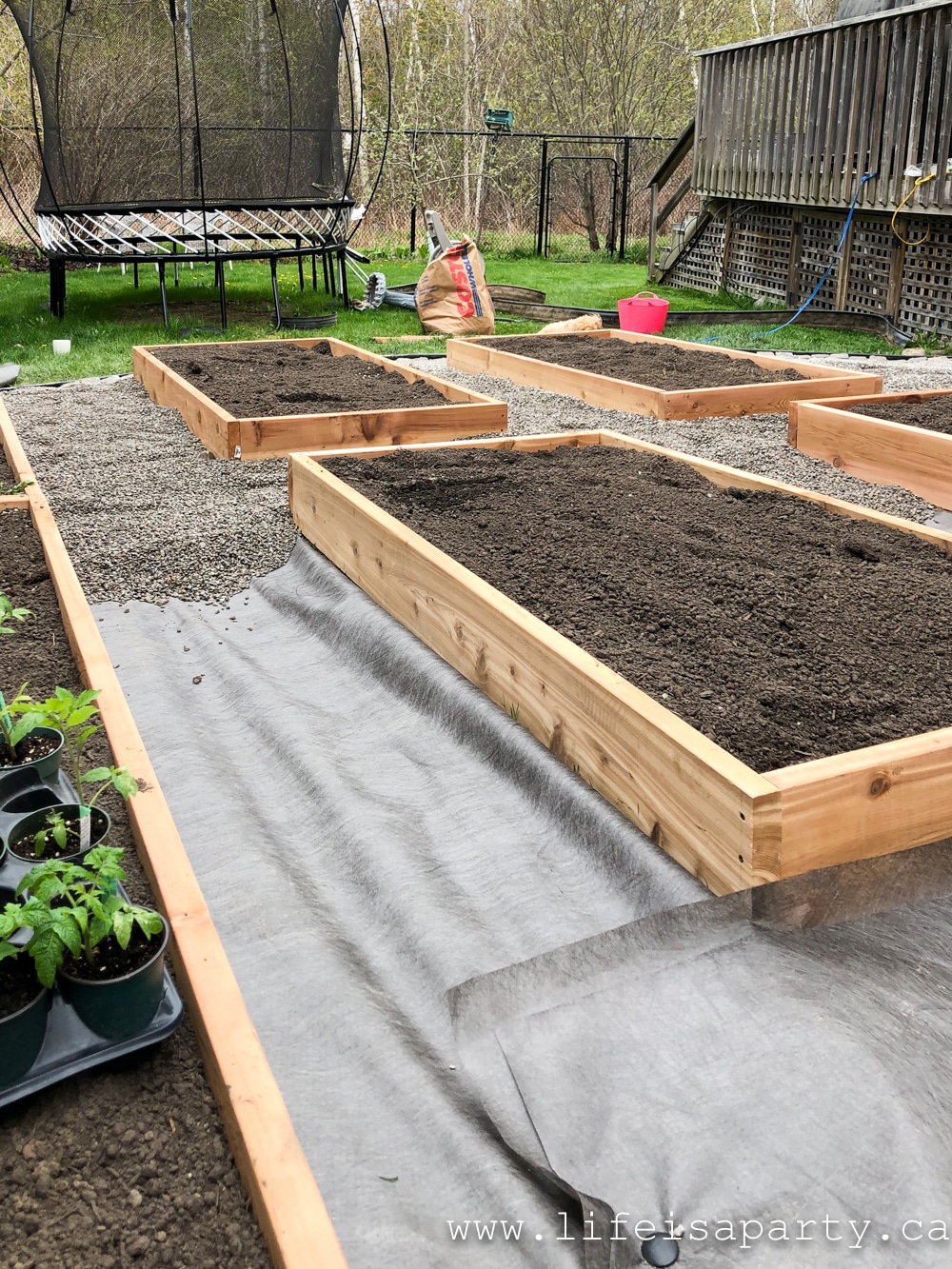
We used landscape fabric underneath it, and layered it directly on top. We didn't bother to remove the grass underneath, since we laid the pea gravel quite thickly and weren't worried about it growing up through. So far it's been great. We wheelbarrowed in 3 cubic yards of pea gravel and 3 cubic yards of topsoil for this project.
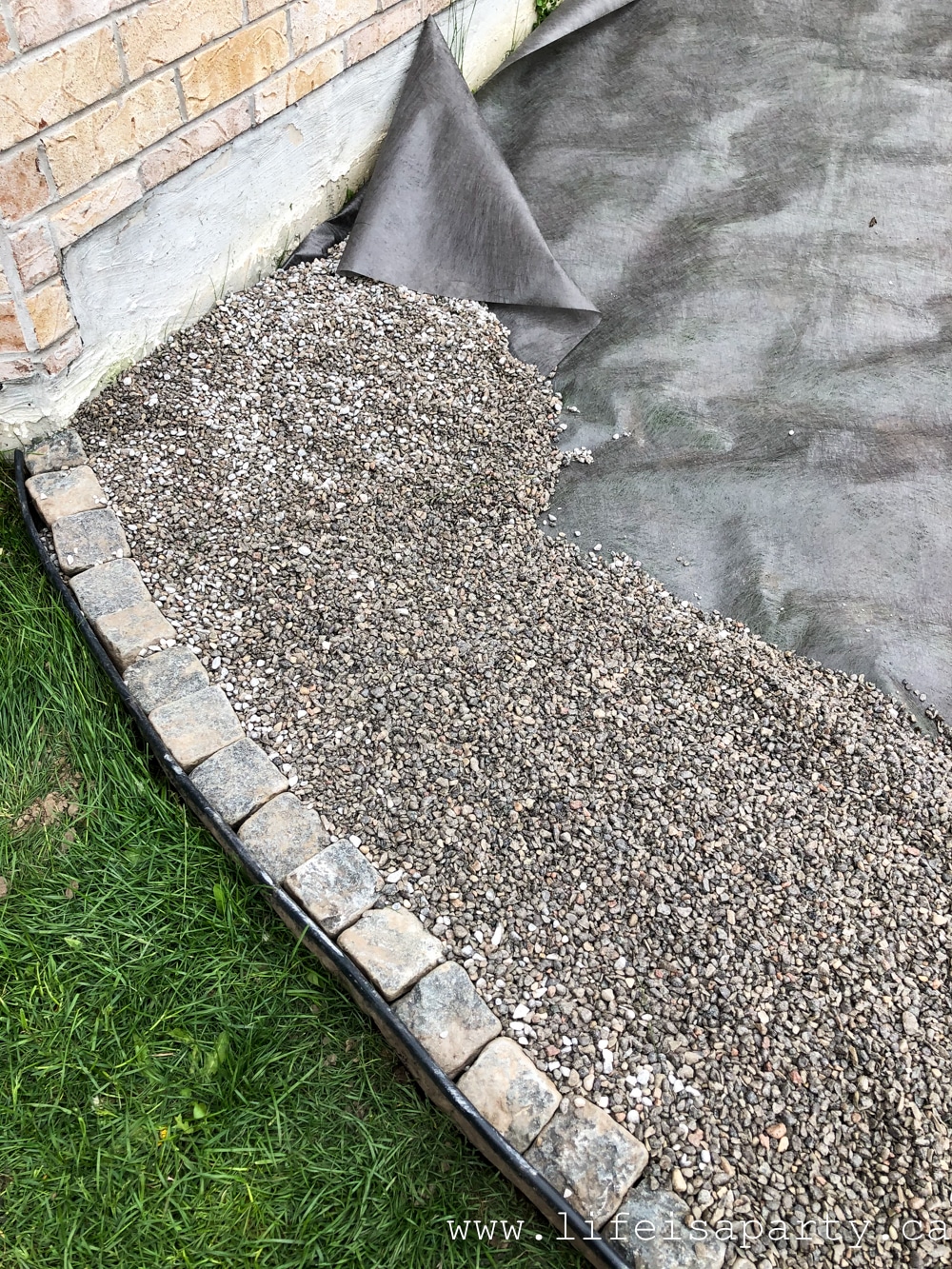
We also had some cobble stone pavers from the old garden and reused them as edging for the beds, and where the pea gravel and lawn meet. They worked perfectly, and their uneven, mismatched shape adds character to the space and helps with that European feel.
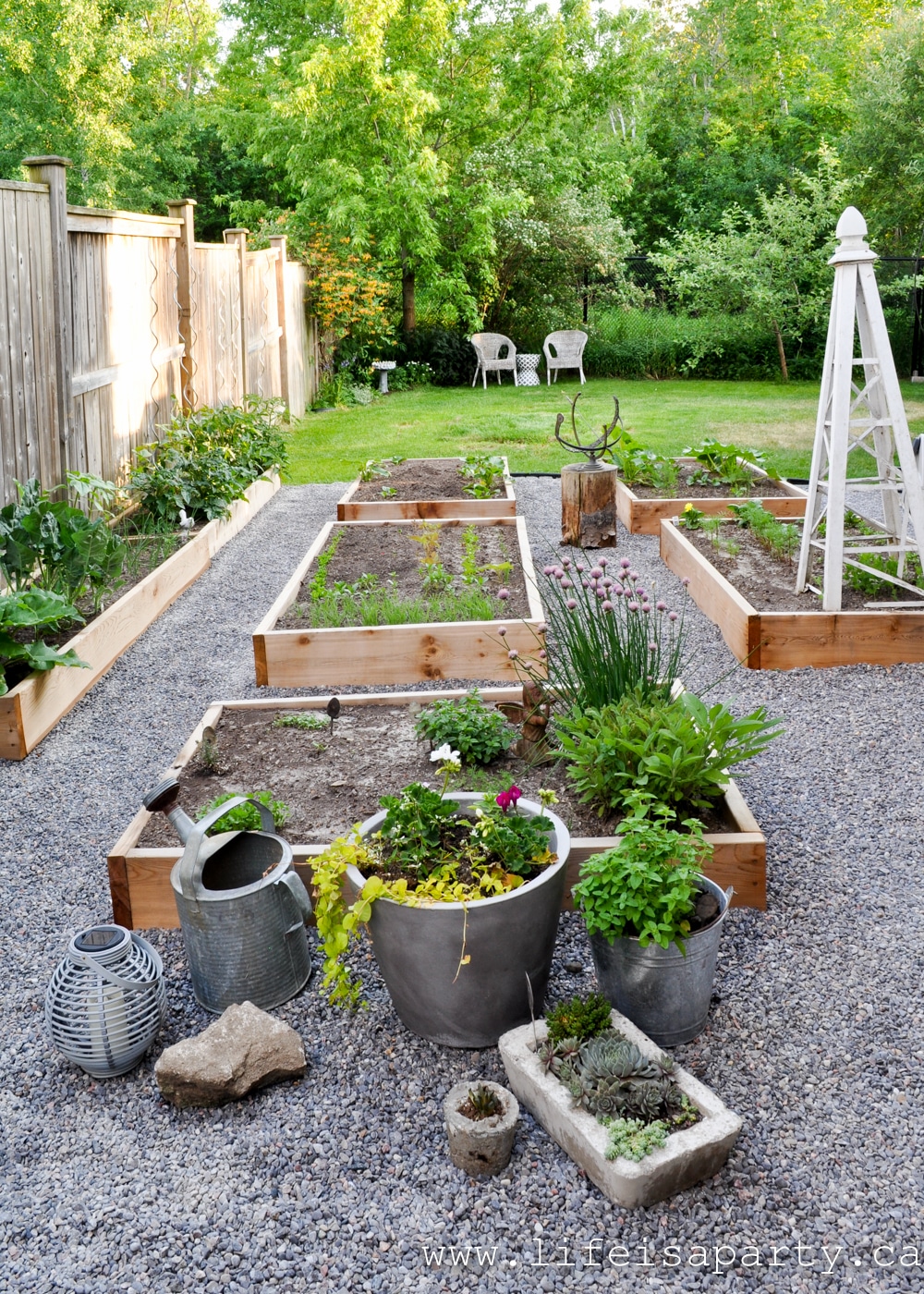
Focal Point
An important thing that a potager garden always includes a focal point like decorative statues or a garden ornament. We recycled the one from our previous veggie garden. This brass sundial is one I've had for years and years. It's screwed into an old stump and perfect for the middle of raised beds.
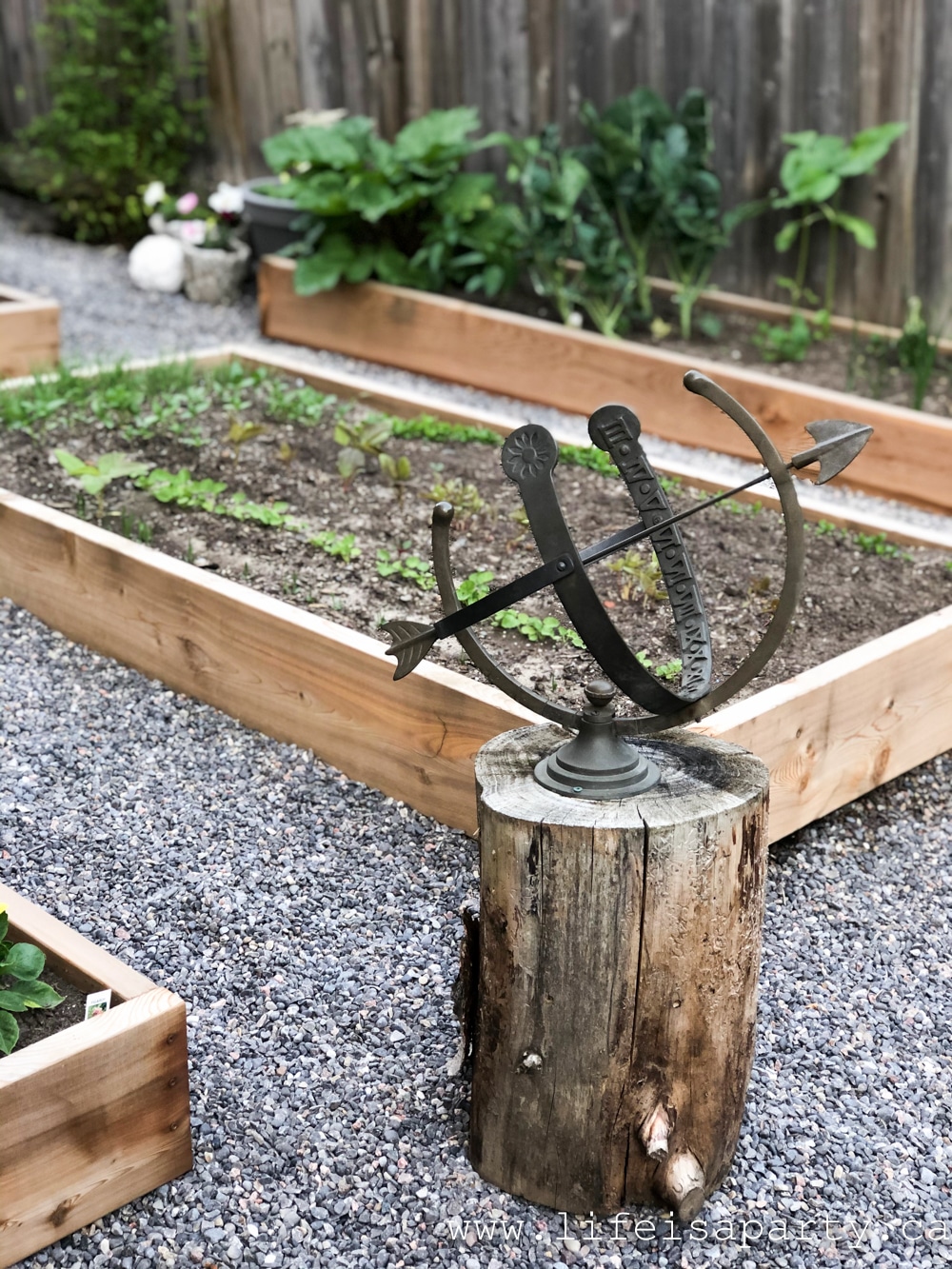
Enclosed By Walls or Fences
Potager gardens are usually enclosed spaces. This side yard small garden is bordered by the brick wall of our house, and the privacy fence, which isn't too far away from our neighbours brick walls. The walls make it feel enclosed like a little courtyard. And the pie shape adds character to the garden.
This space was very much unused in the past. We enjoyed the little veggie garden that was there, but the rest of the space was quite wasted. The new garden, sitting area and shed are a great use of the space.
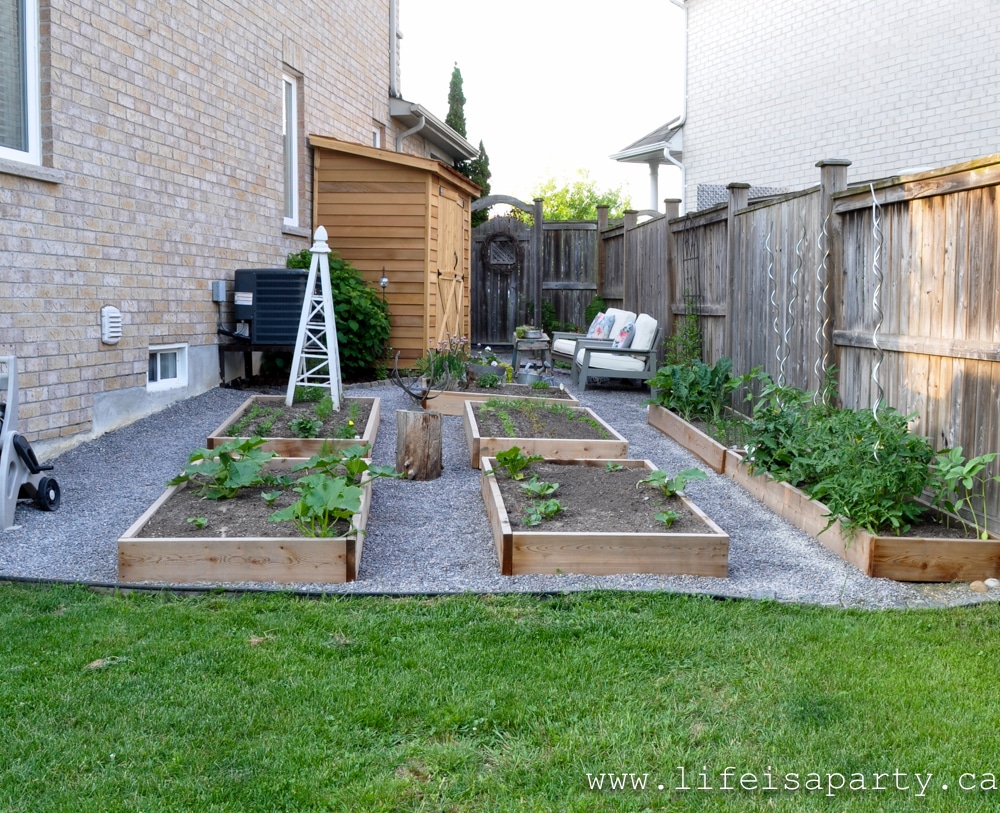
Close To The Kitchen
Typically potager gardens are near to the kitchen to make picking flowers, herbs and veggies for cooking nice and easy. Our kitchen widow over looks the new beautiful kitchen garden, and it's just a few steps away from our back deck. If you're considering adding a potager garden to your space, choose a spot nice and near your house.
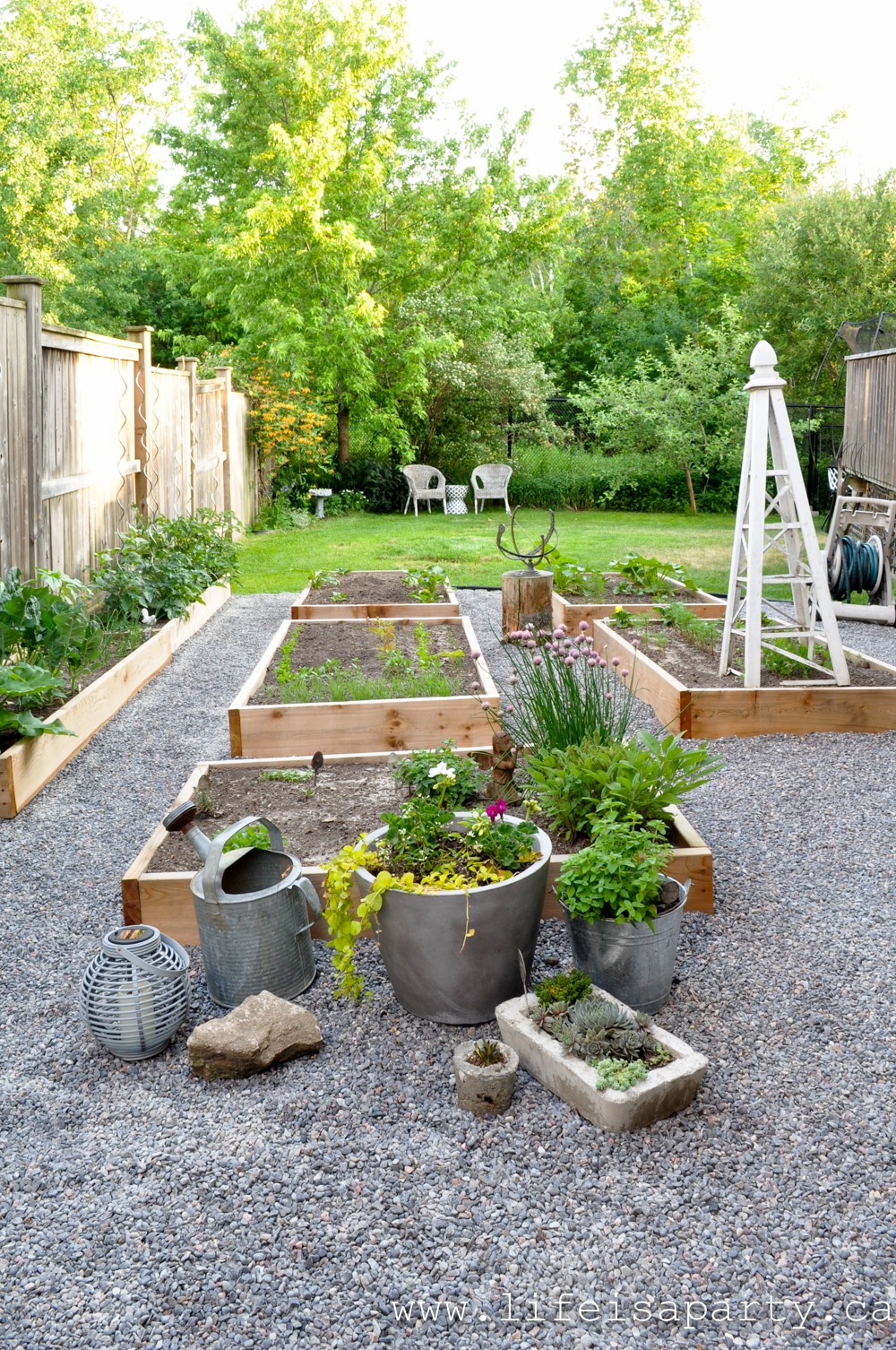
The Garden Shed
Probably the biggest addition to this space was the garden shed. We picked it out on-line and then had to wait on delays in shipping due to covid. It is a kit, and we were a little worried about putting it together ourselves.
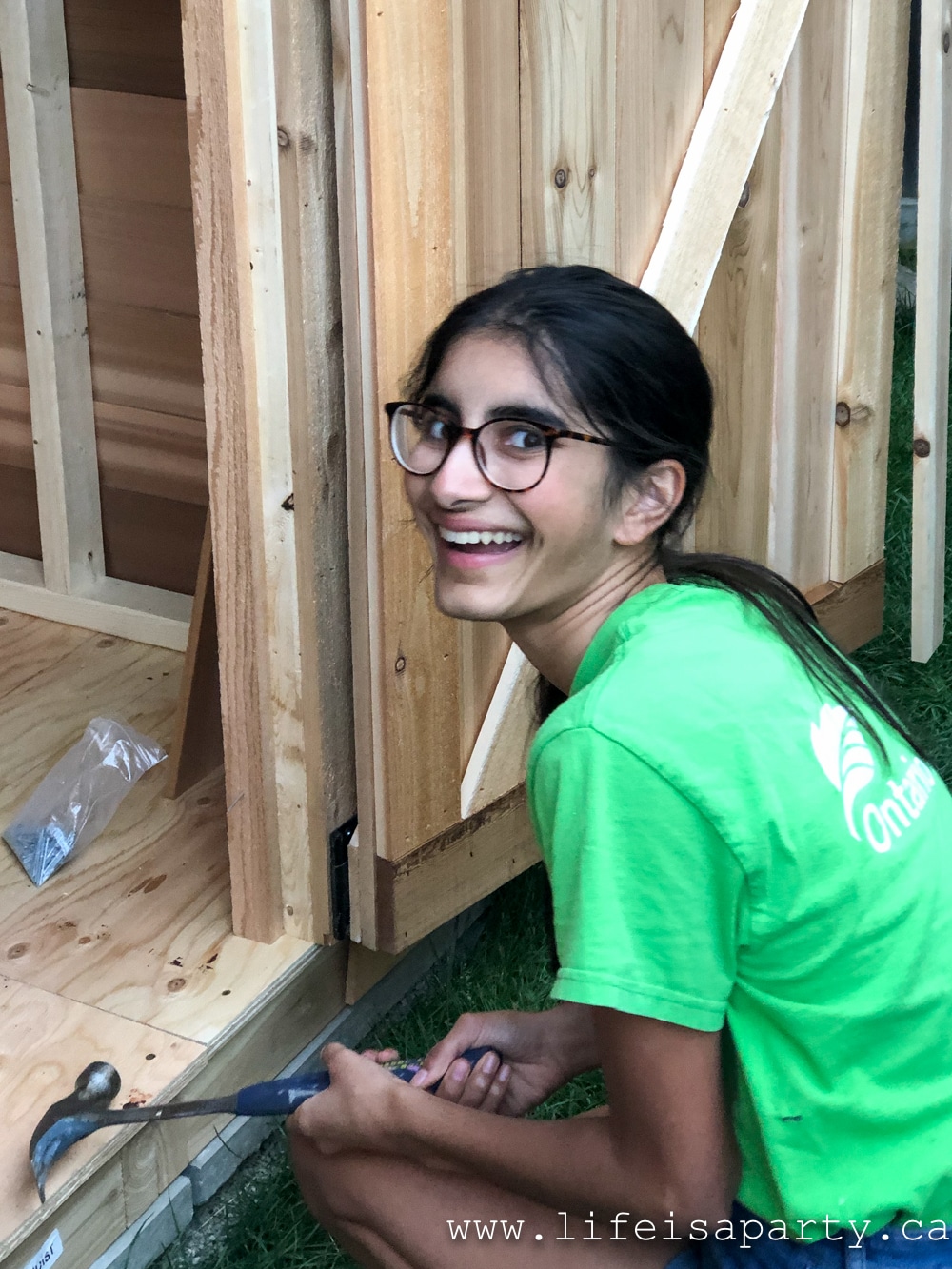
But, it is basically just a series of screws and nails, time consuming but not difficult. Our daughters helped us and the four of us had it all assembled in a weekend. We love how it turned out. It's made of cedar and smells and looks beautiful. It's nice that it matches the cedar raised beds too. Over time the cedar wood will grey.

Our main goal with the garden shed was to give us some storage for garden furniture during Canada's harsh and snowy winter months. But during the other three seasons on the year, I thought it would be fun to set it up as a bit of an office she shed. It has actually given quite a lot of space for garden items in the winter, when strategically packed up.
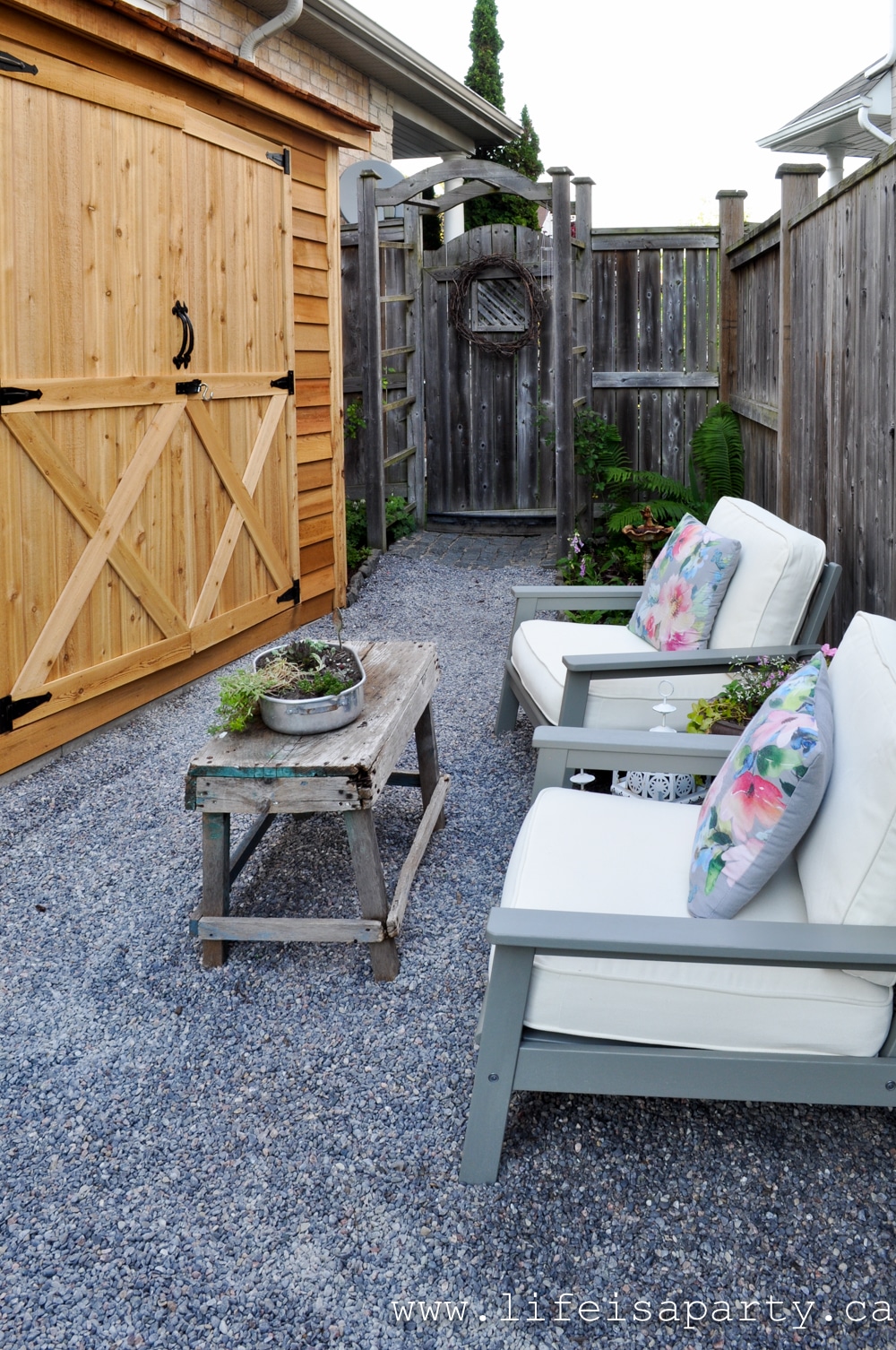
Decorating the She Shed
We created a small desk on one side. It's basically a shelf that we can easily lift out when we need the space for storage in the winter.
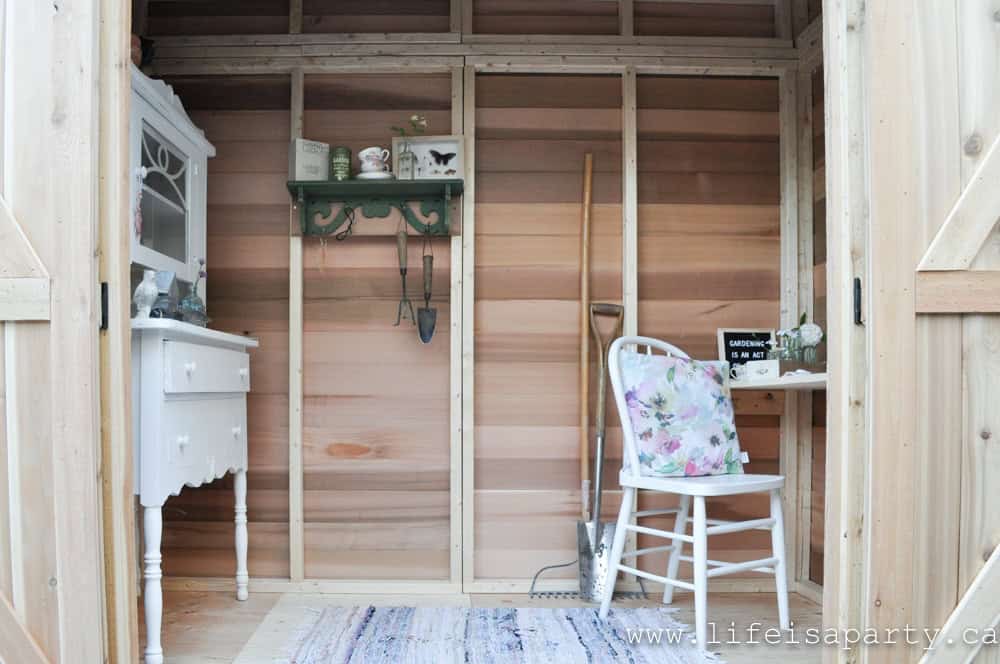
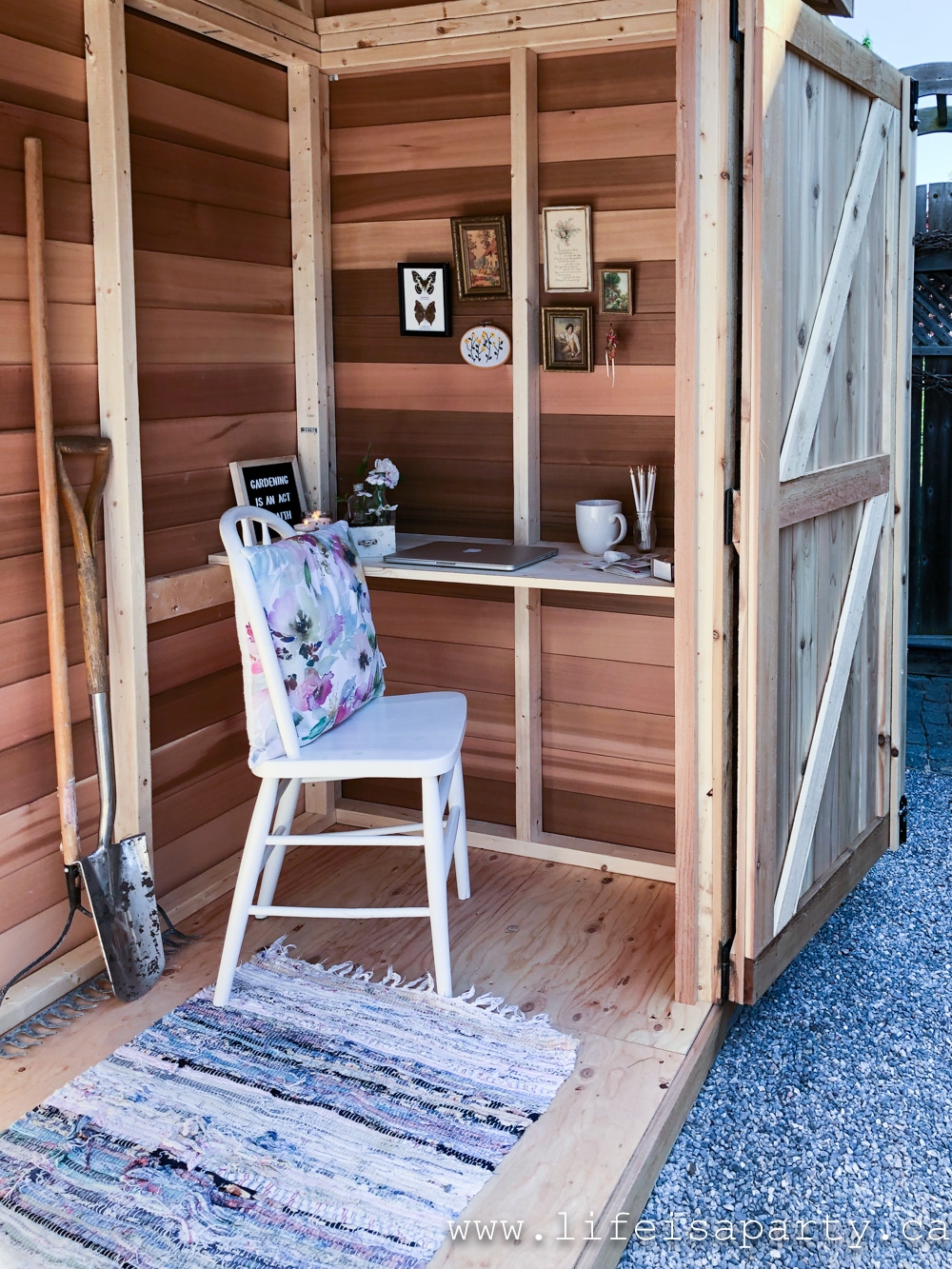
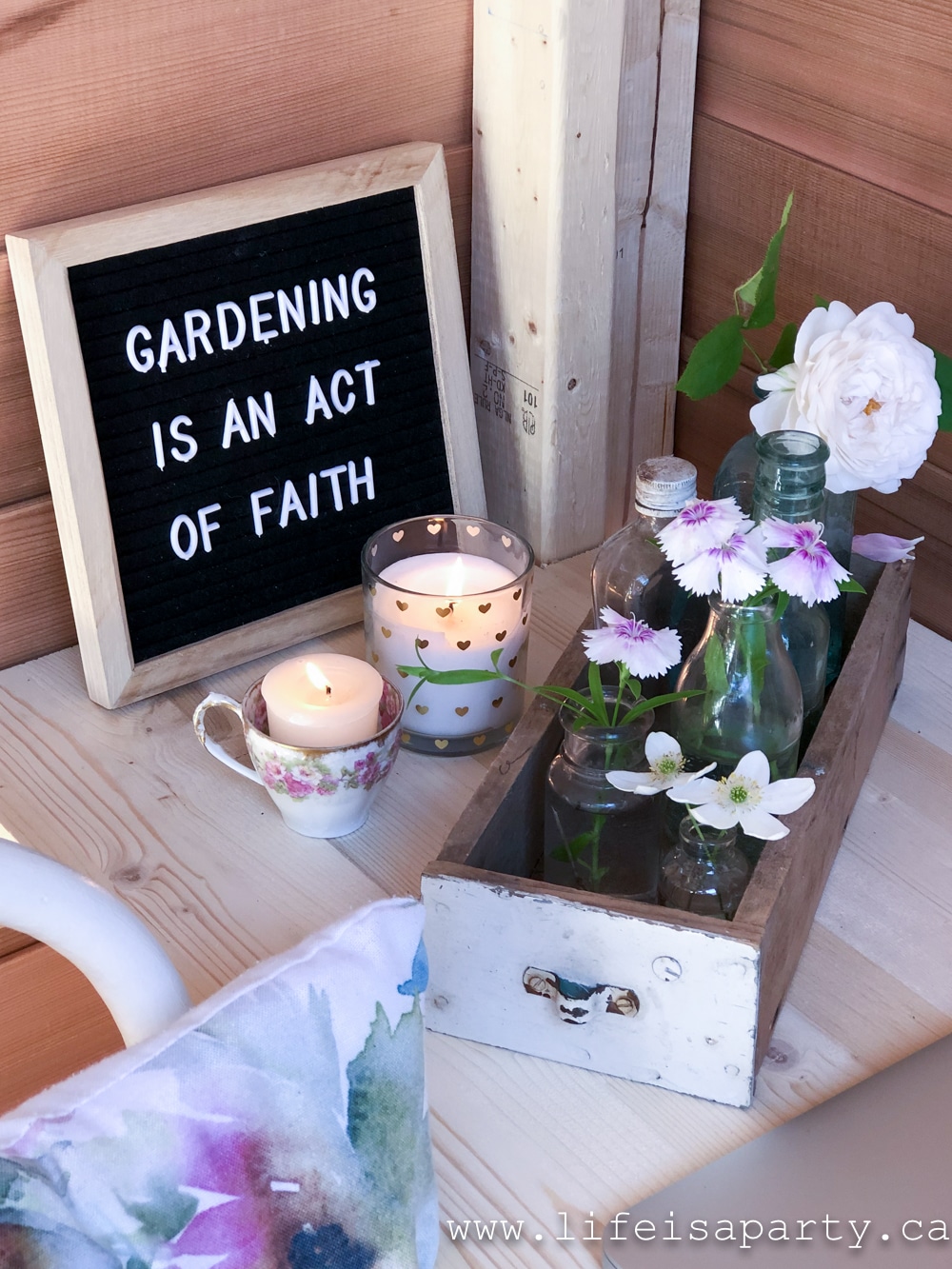
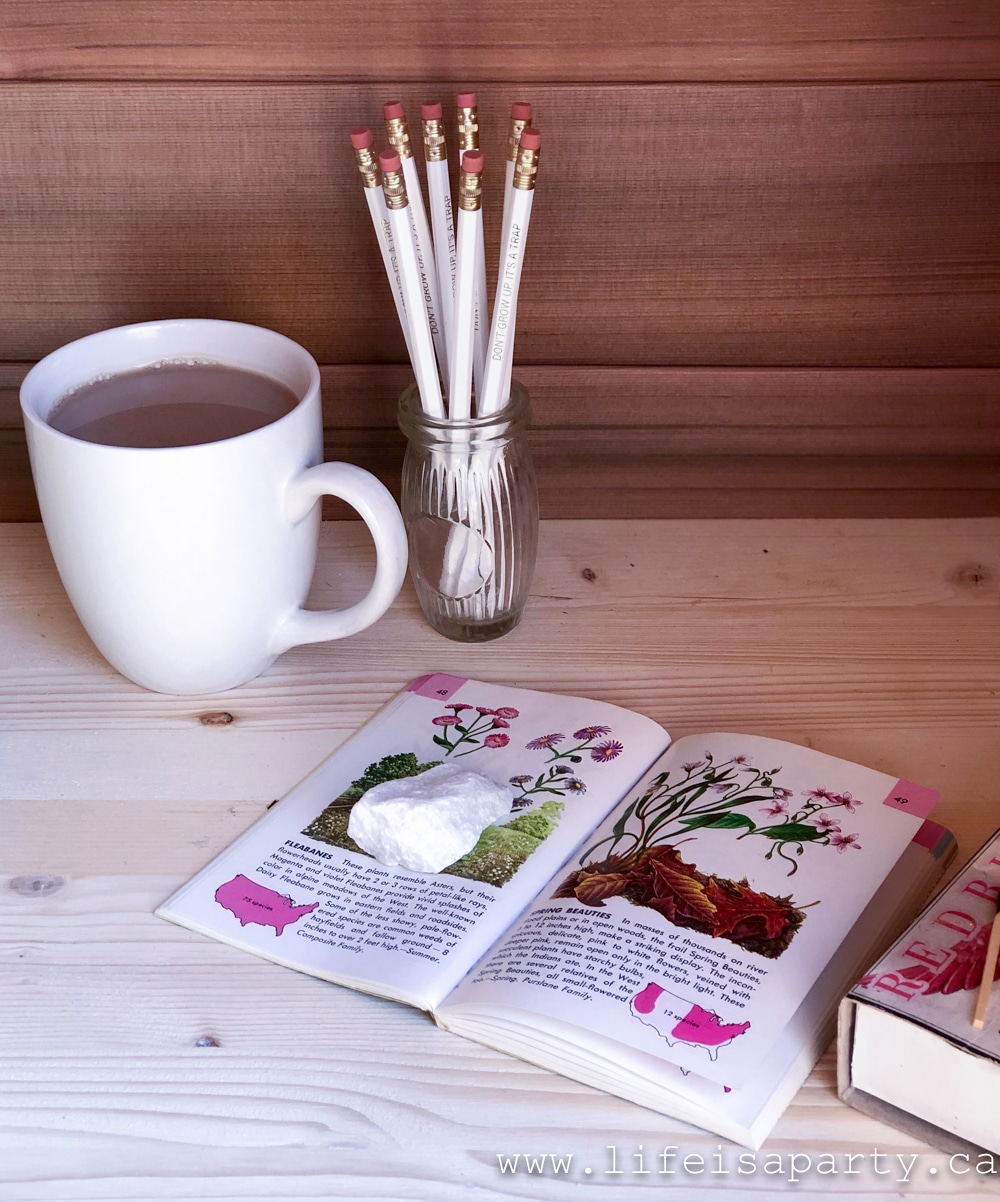
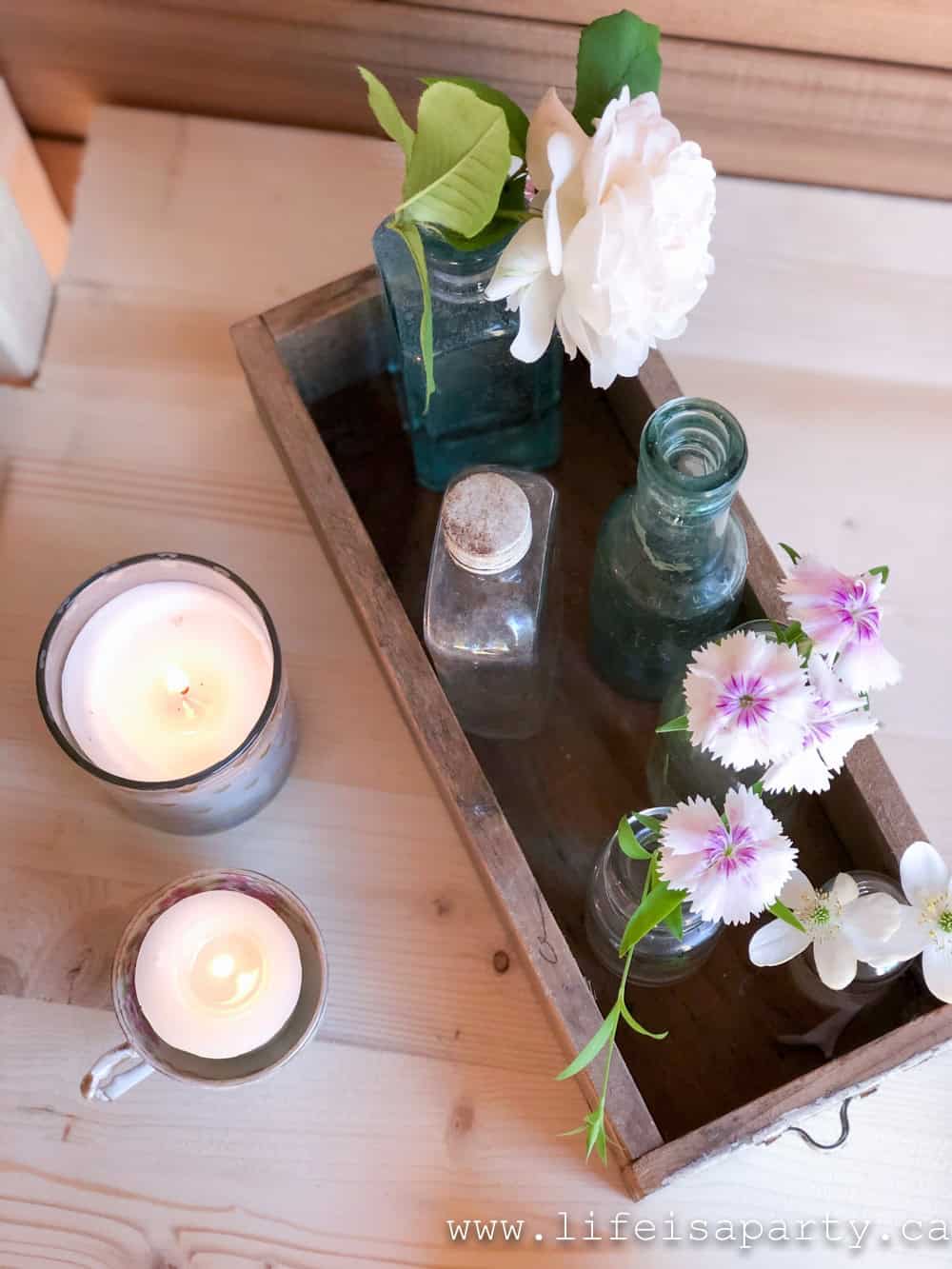
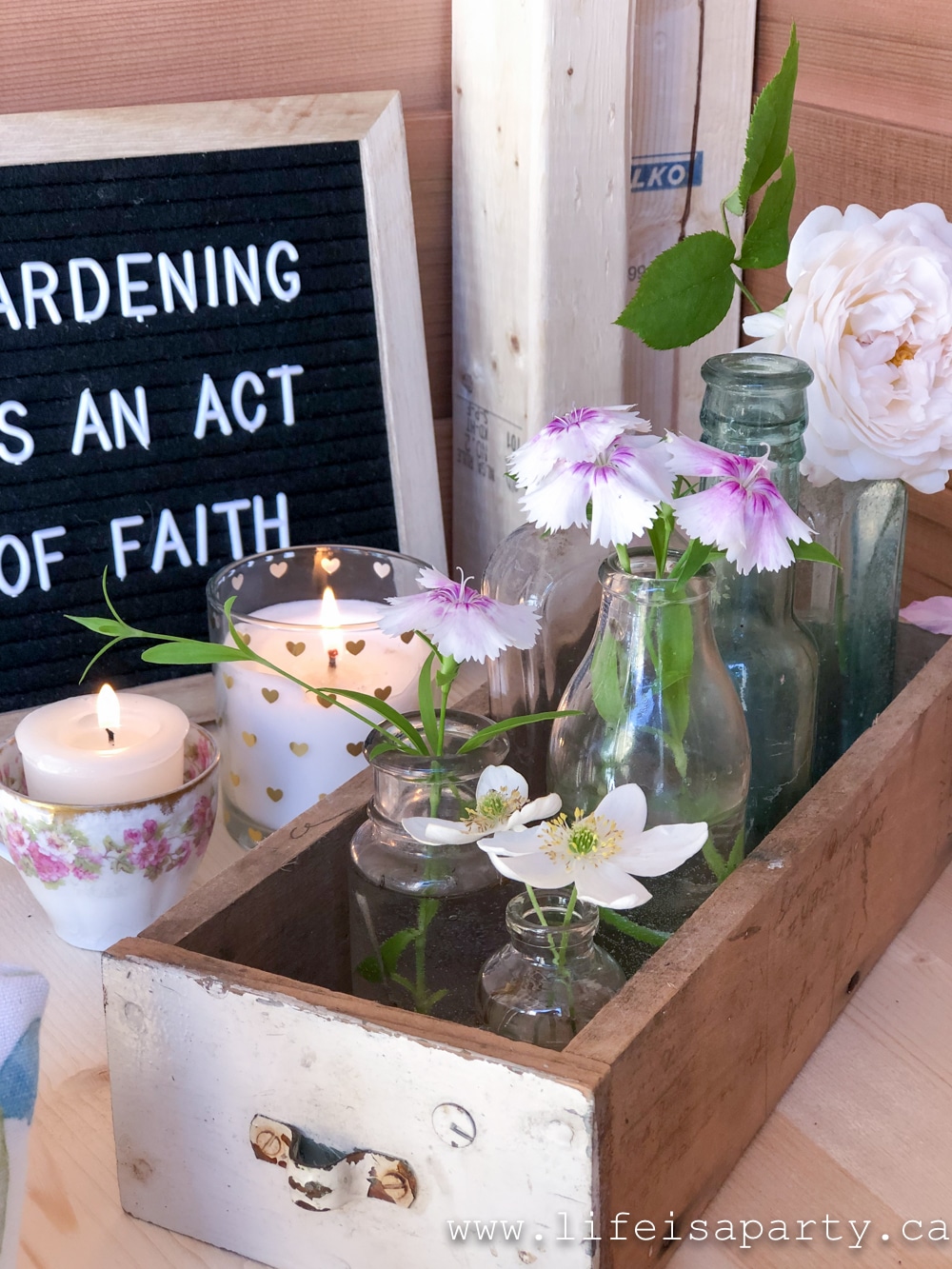
I've created a vintage feel to the space by using some antiques. To create the gallery wall I used mostly thrift store finds of old art pieces. They're held in place with sticky hooks.
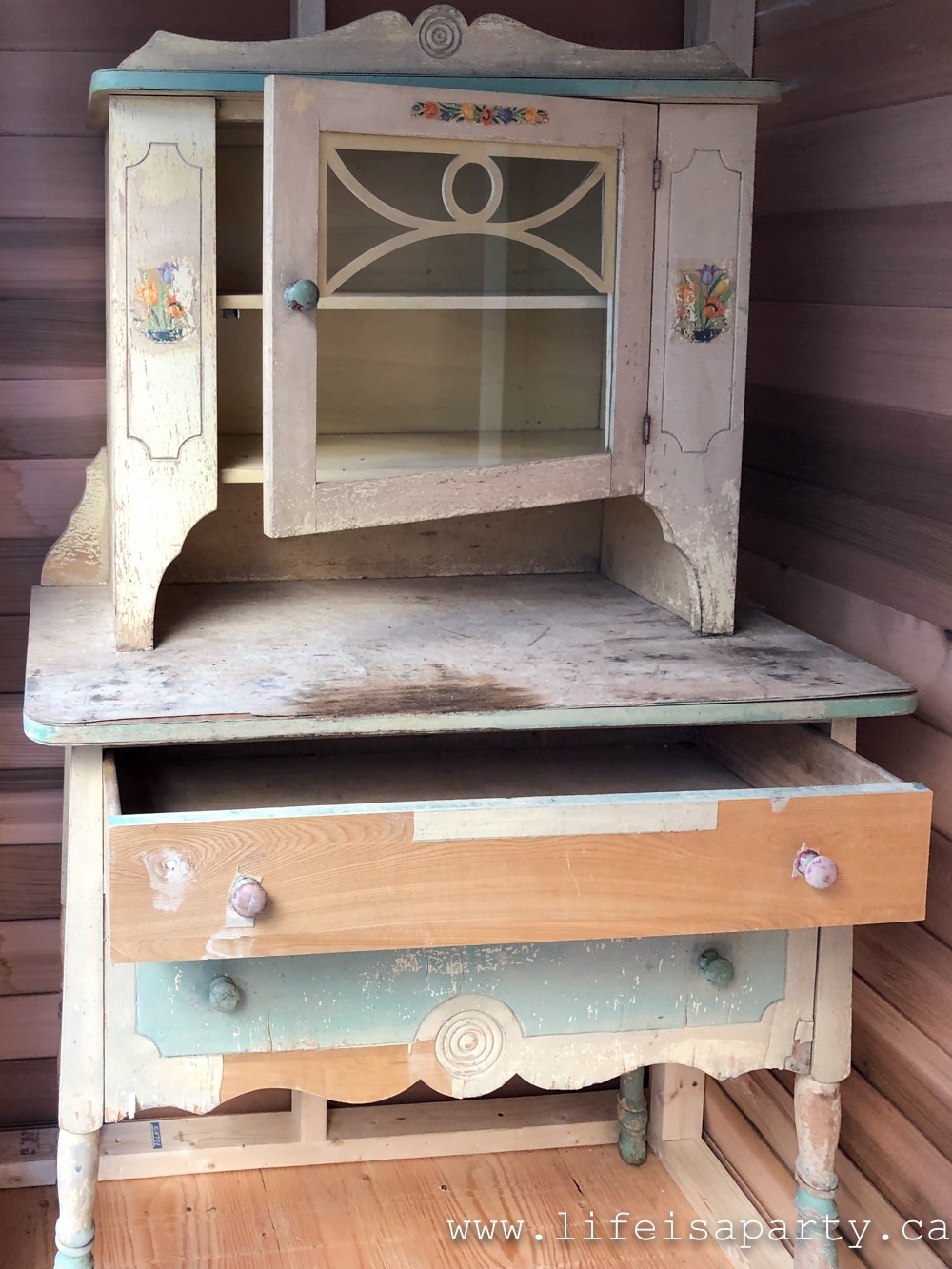
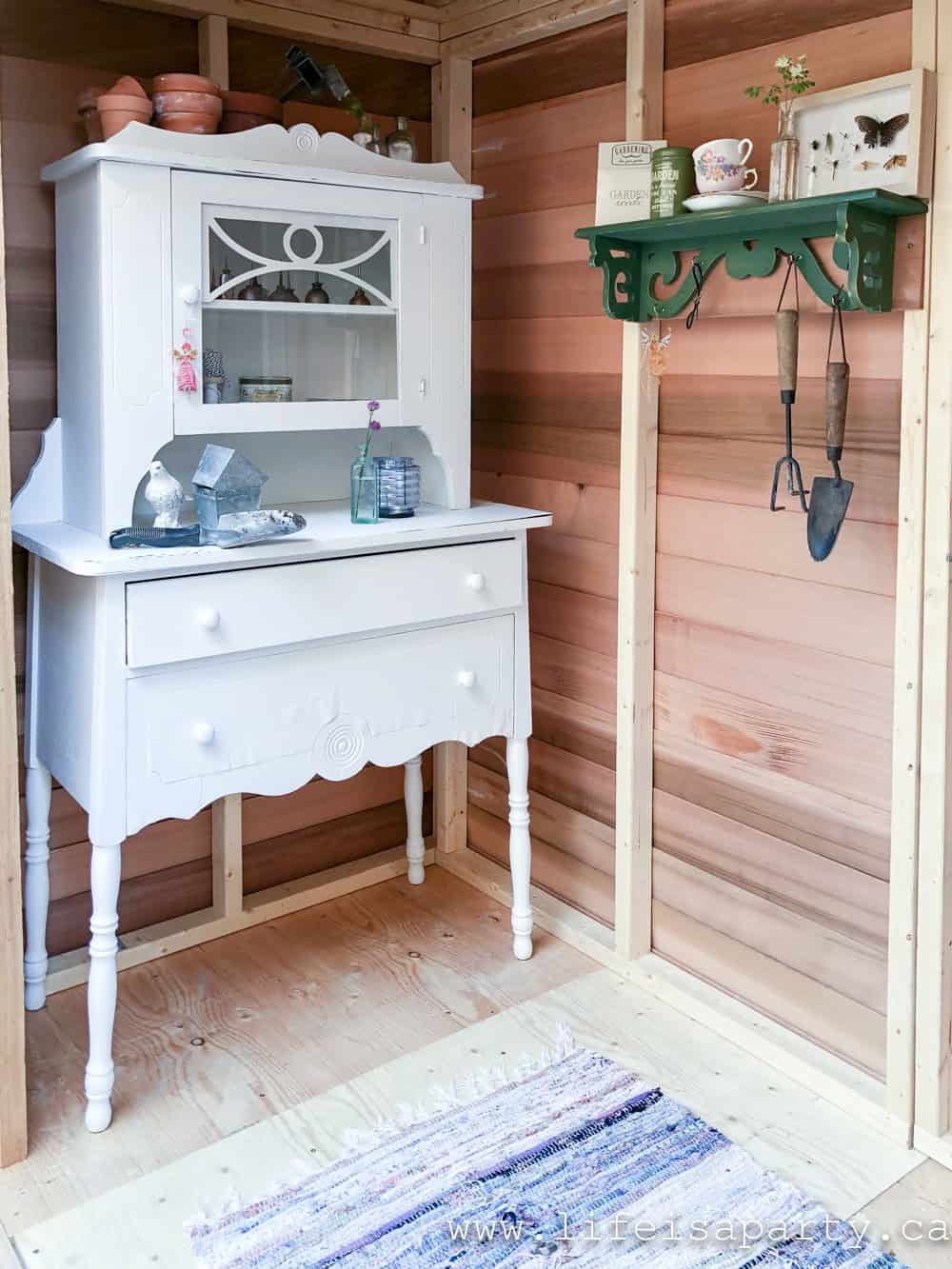
The cabinet is an old one with some previous damage I had in my basement. I gave it a bit of a makeover with some white paint. It will be perfect for storing seeds, garden tools, and flower pots. On the shelf I added my collection of antique oil cans. It seemed like the perfect addition for a tool shed.
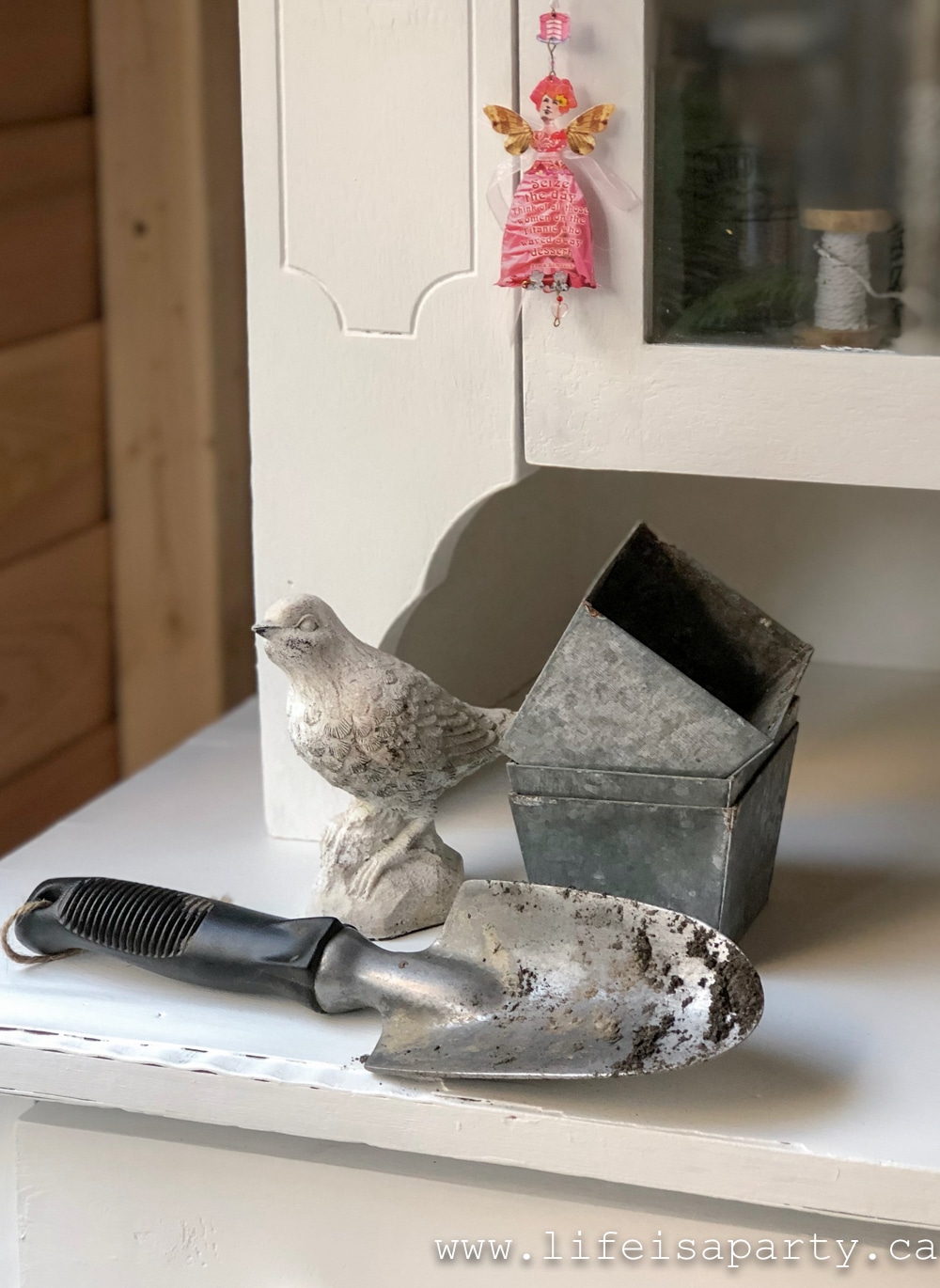
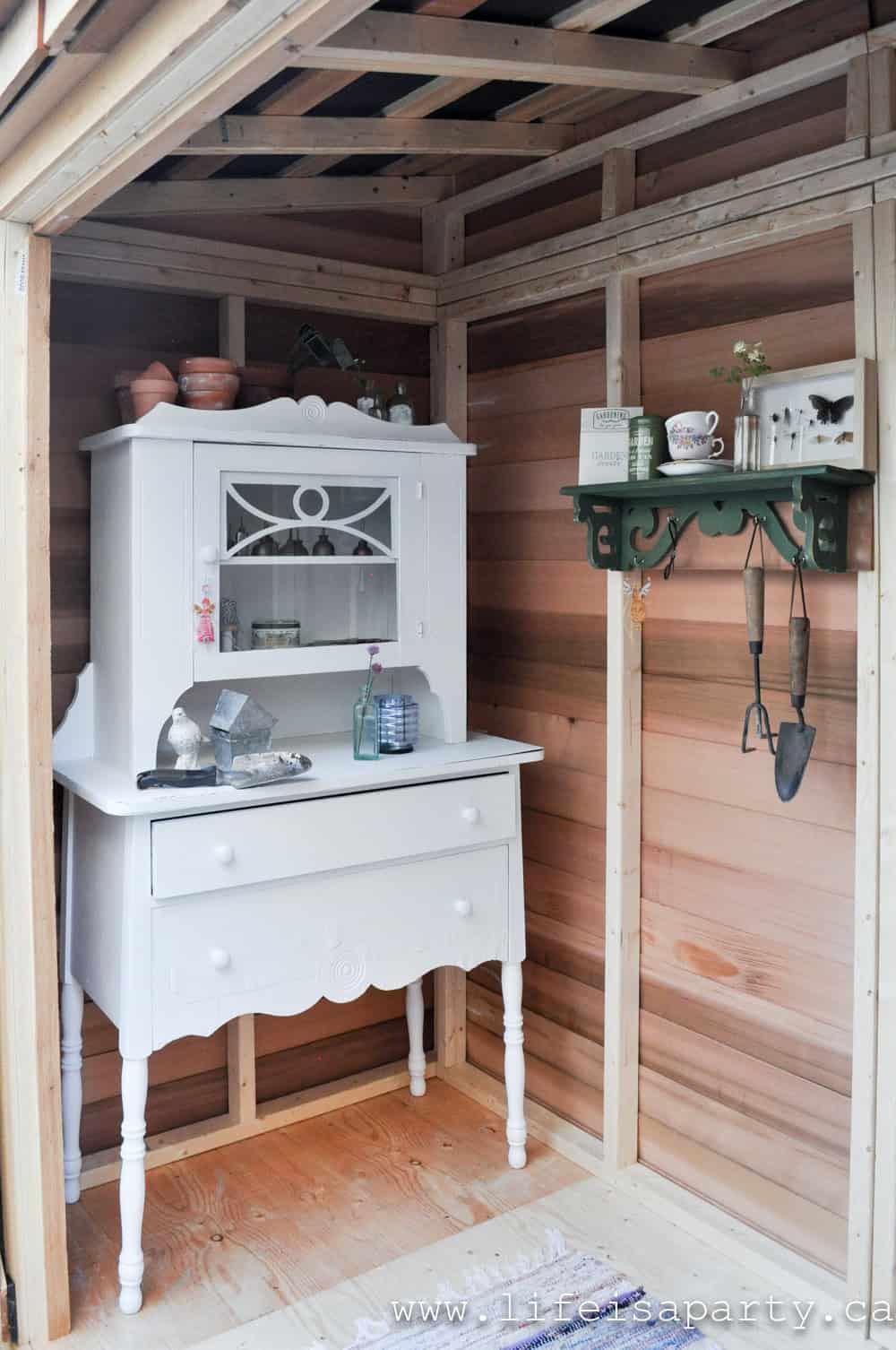
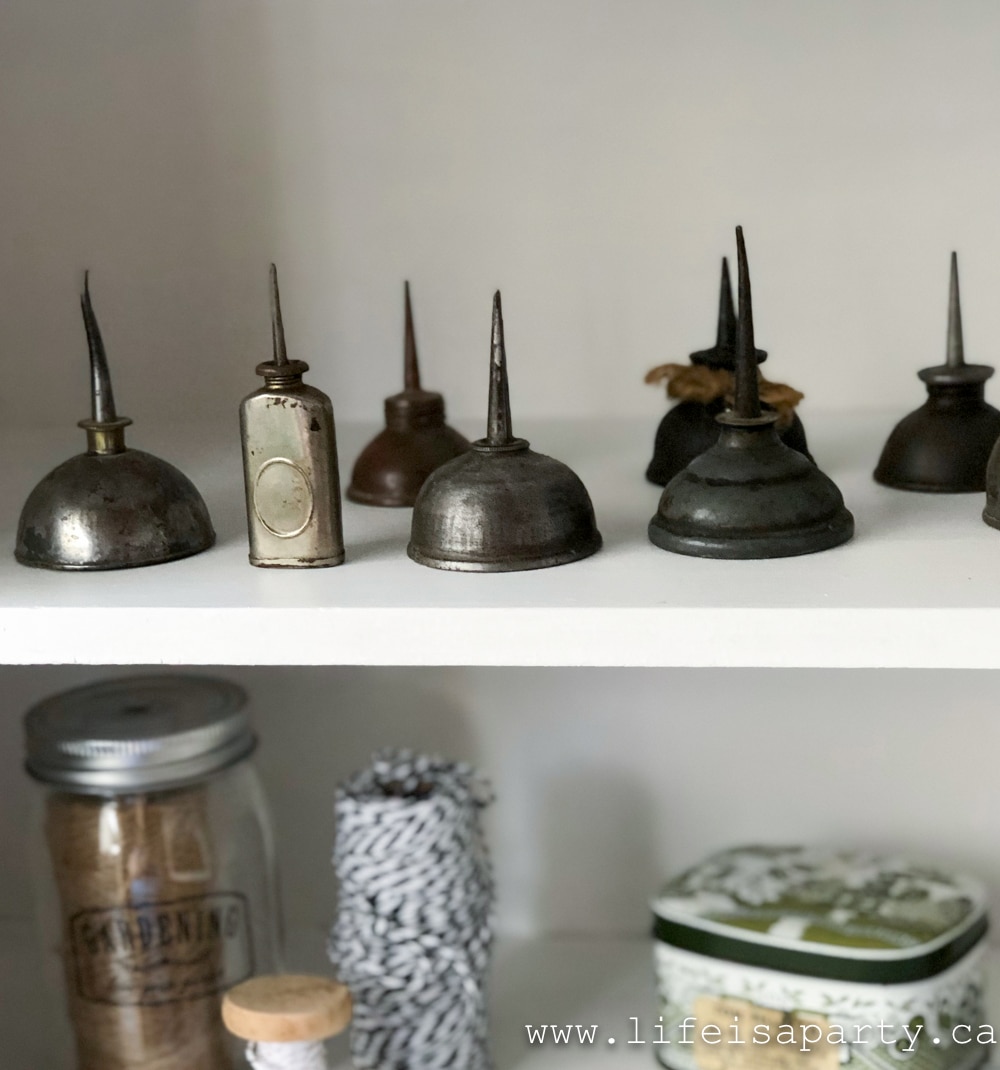
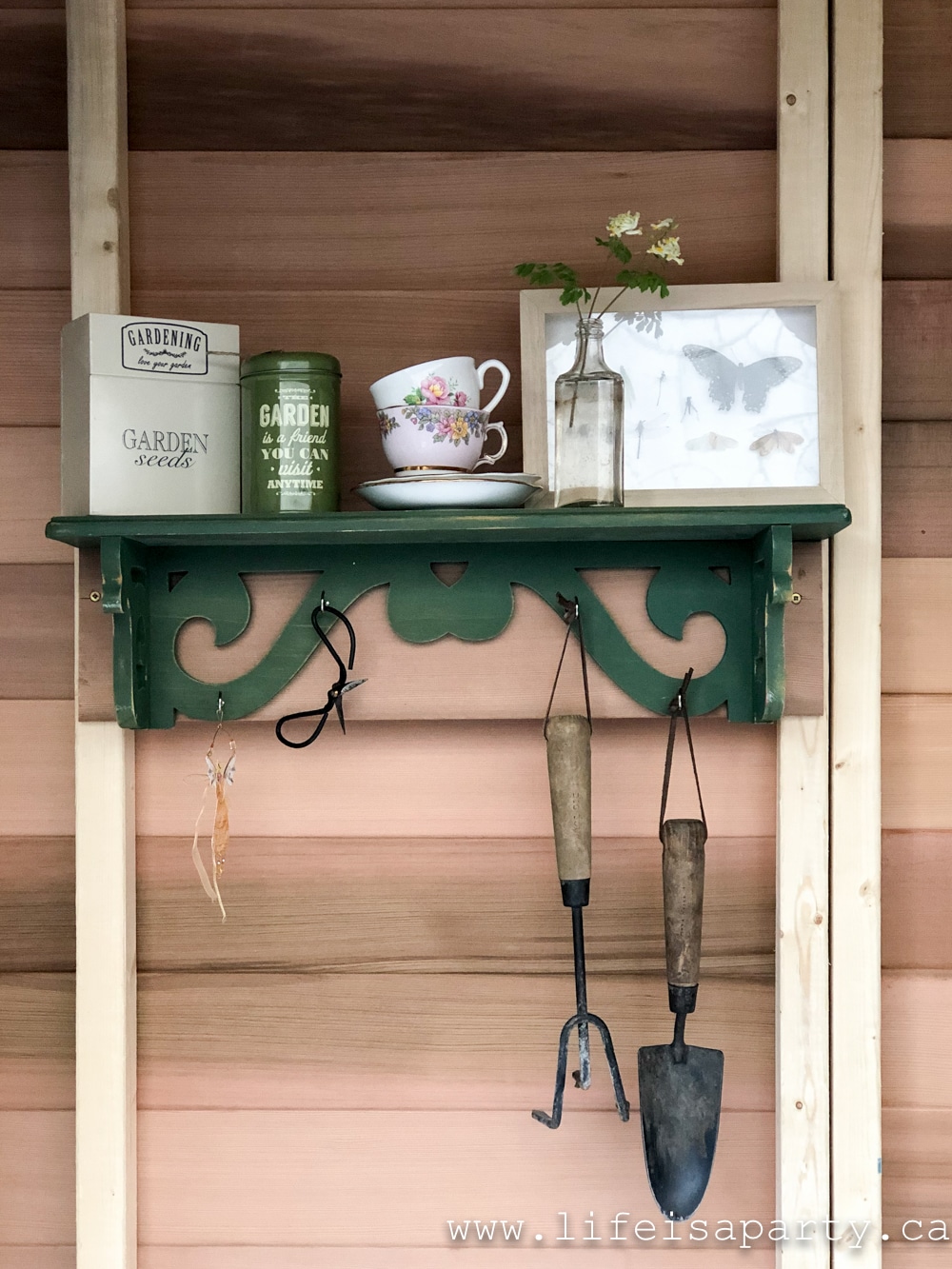
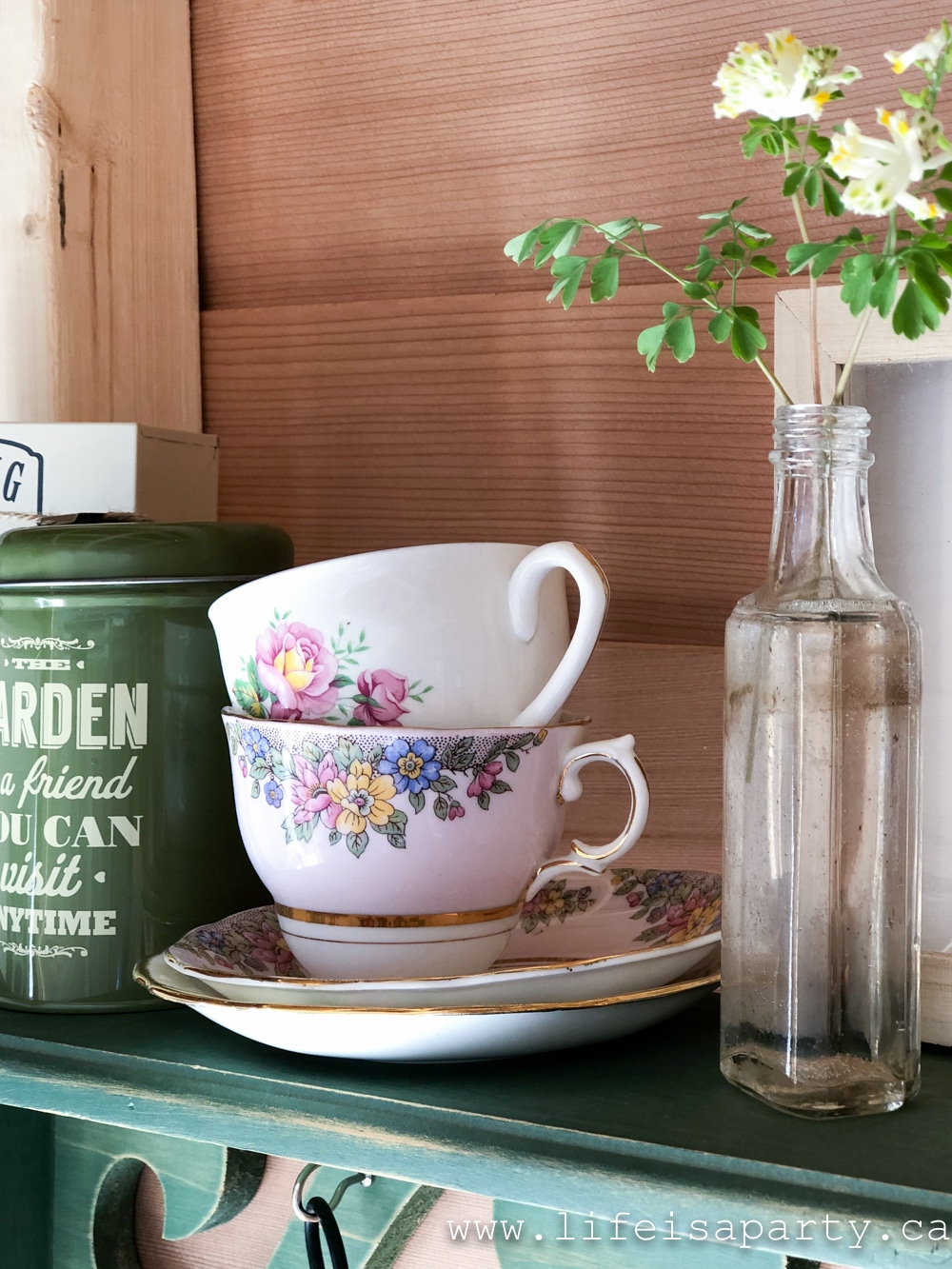
The Seating Area
Potager gardens don't traditionally have a seating area, but this space is so sweet, and is the only spot in our yard that is shady in the early evening so I thought that a little seating area would be a great addition. To create the seating area I used more of the pea gravel that we used for the pathways and added some comfortable chairs and a rustic coffee table. It's made a beautiful vantage point to admire the garden.
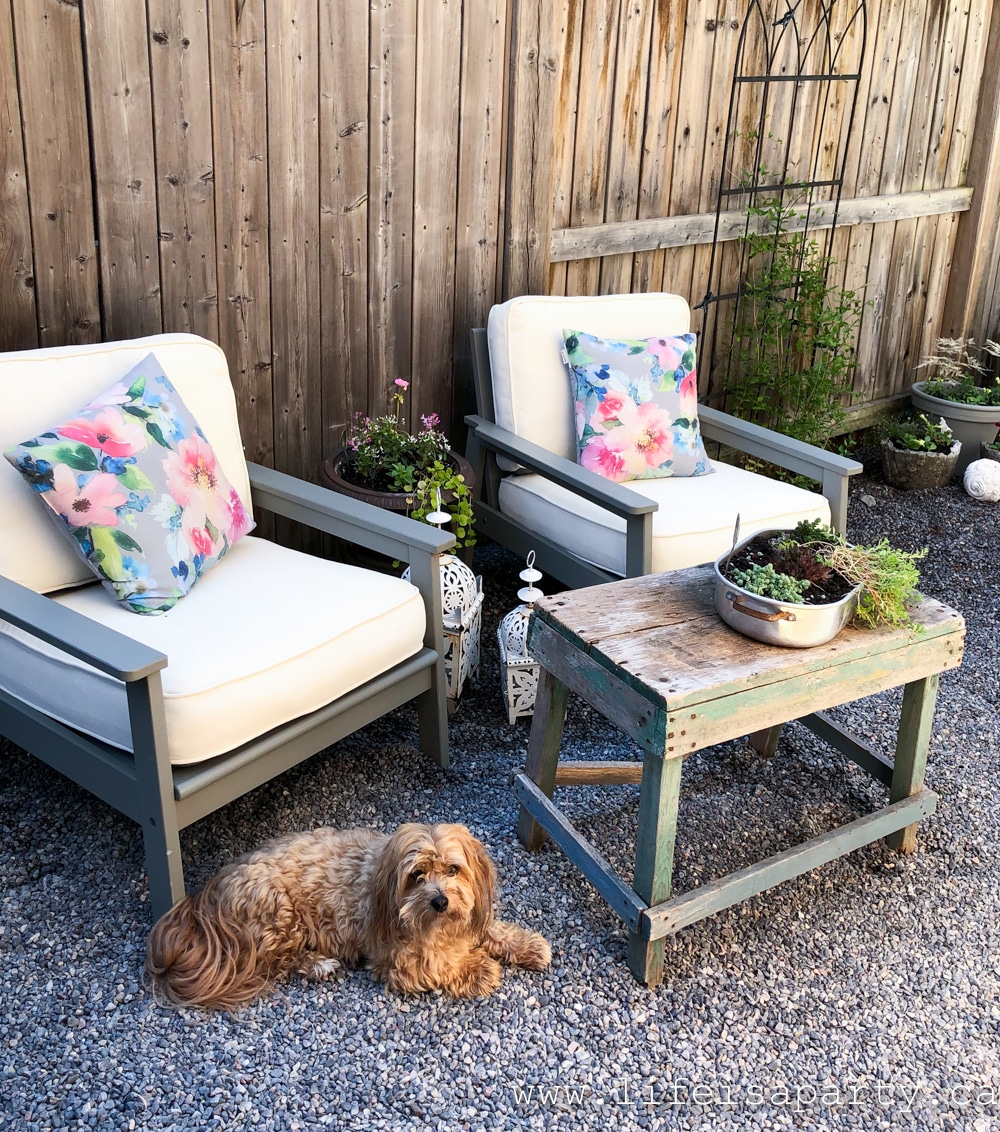
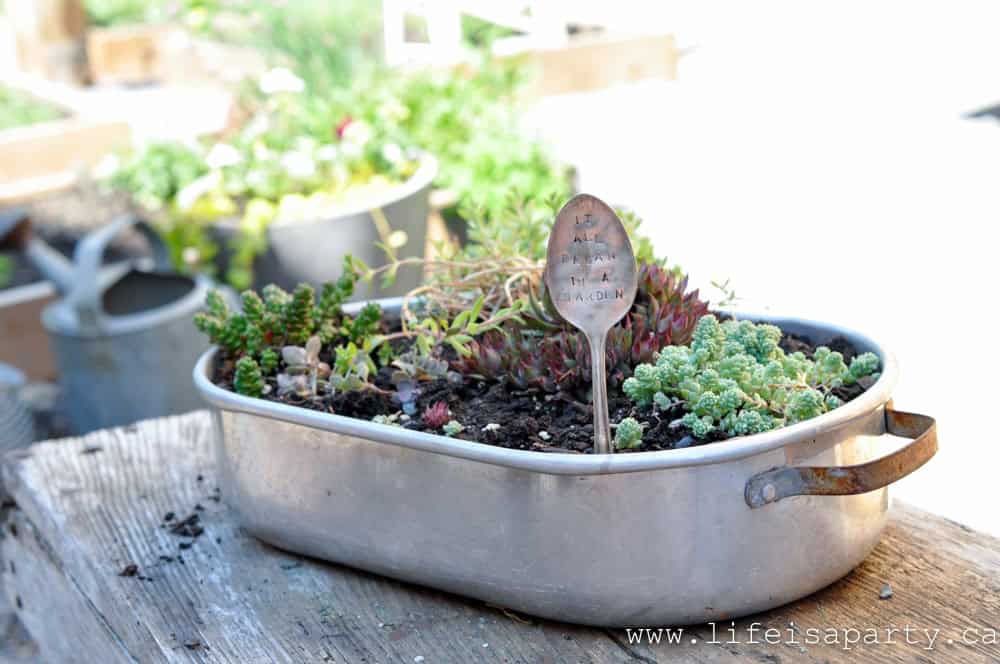
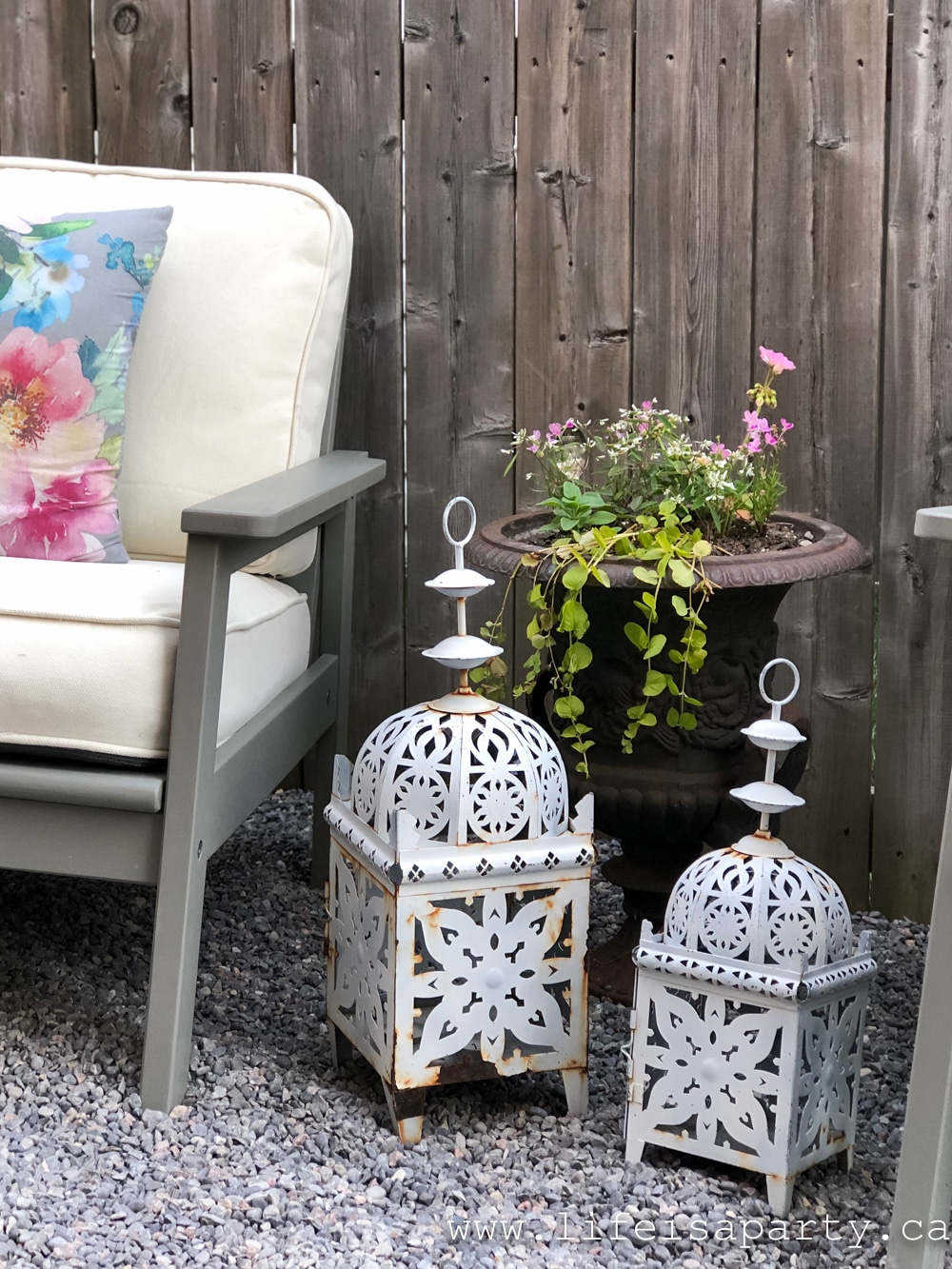
The seating area was also the perfect spot to add in a collection of eclectic pots filled with annuals for a little more colour. All the pots are different but are unified by the colour grey.
One of the marks of a potager garden is beautiful additions like structures, pots, and bird baths. I've positioned these near the seating to be enjoyed.
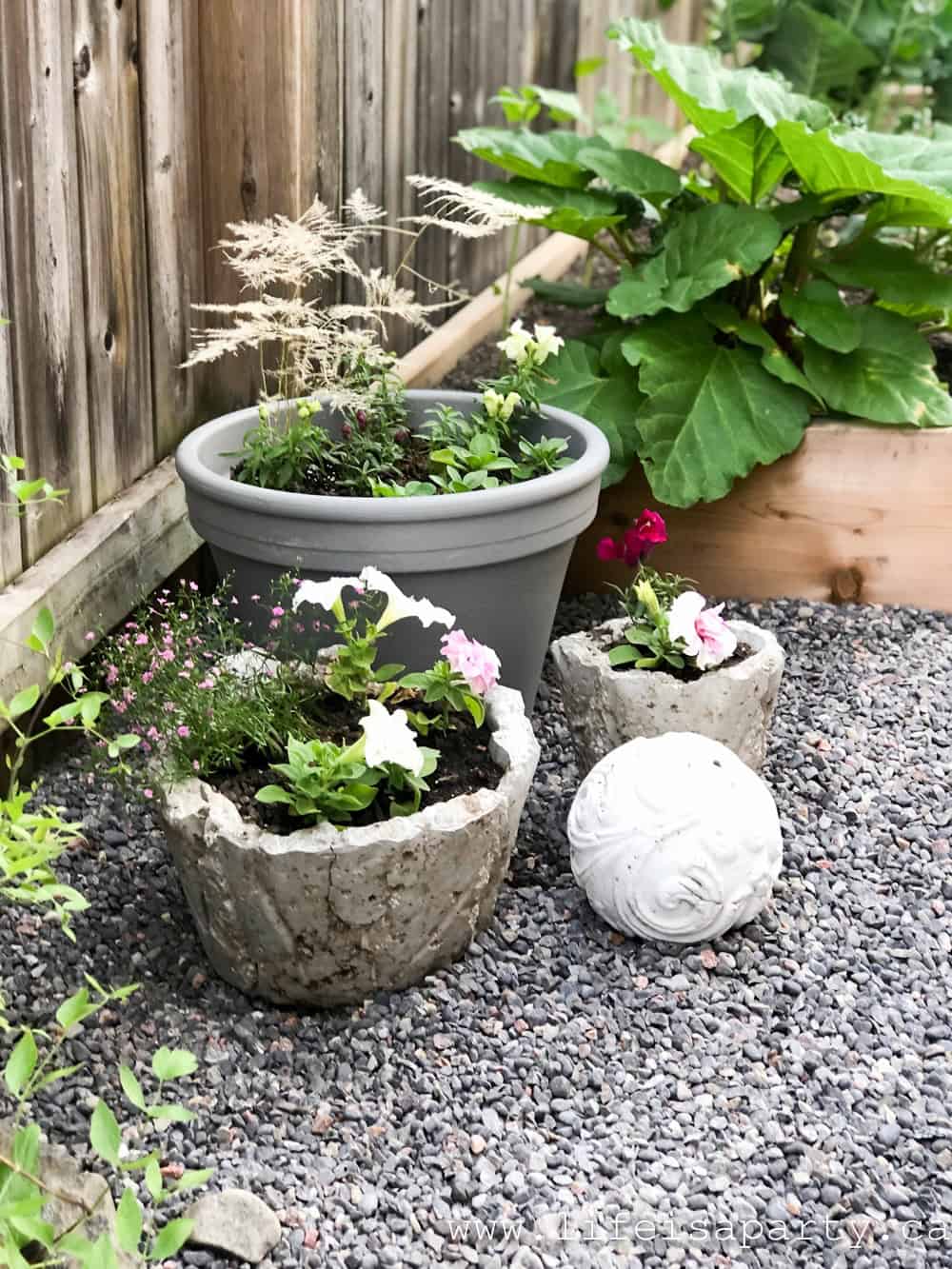
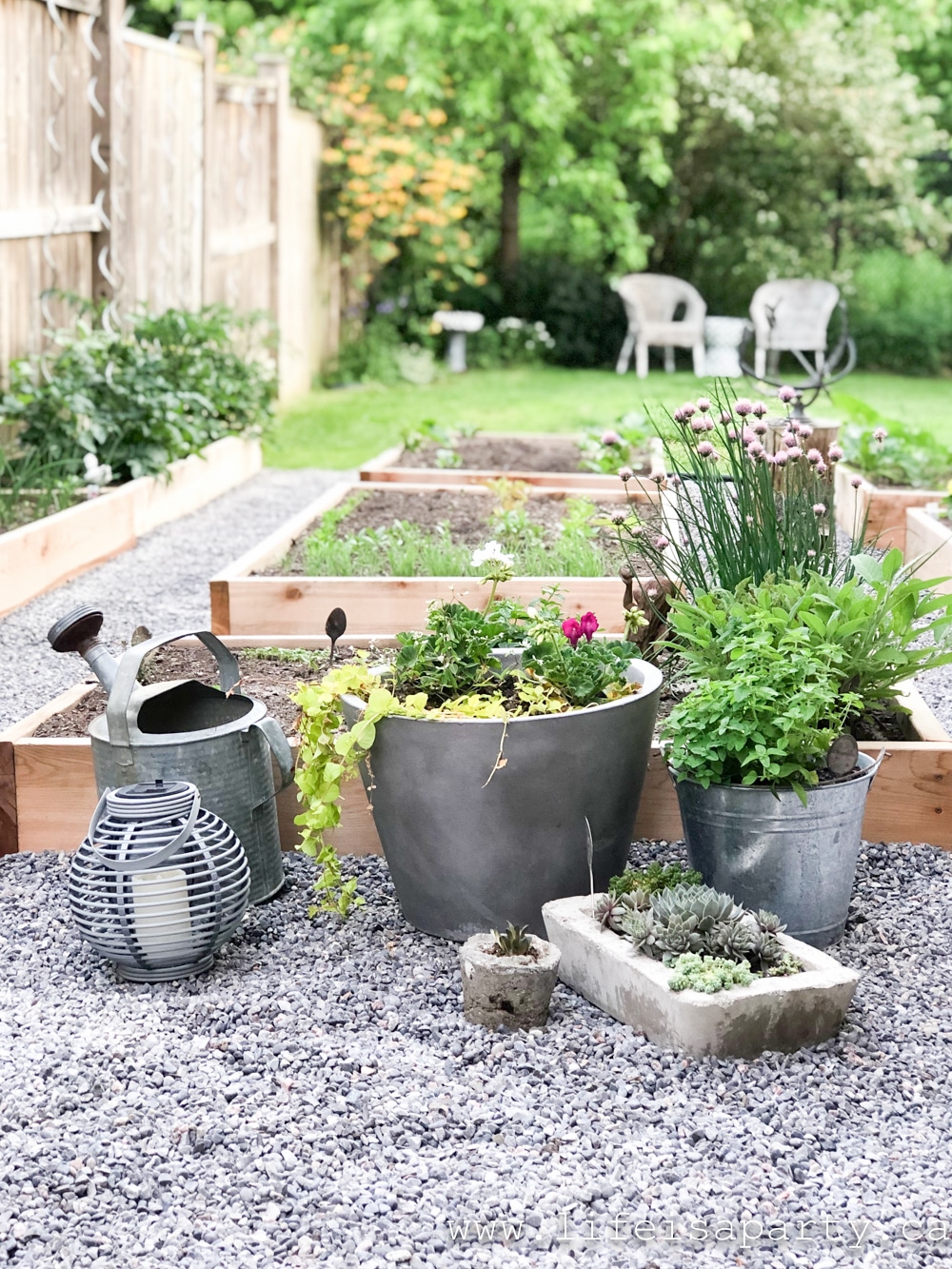
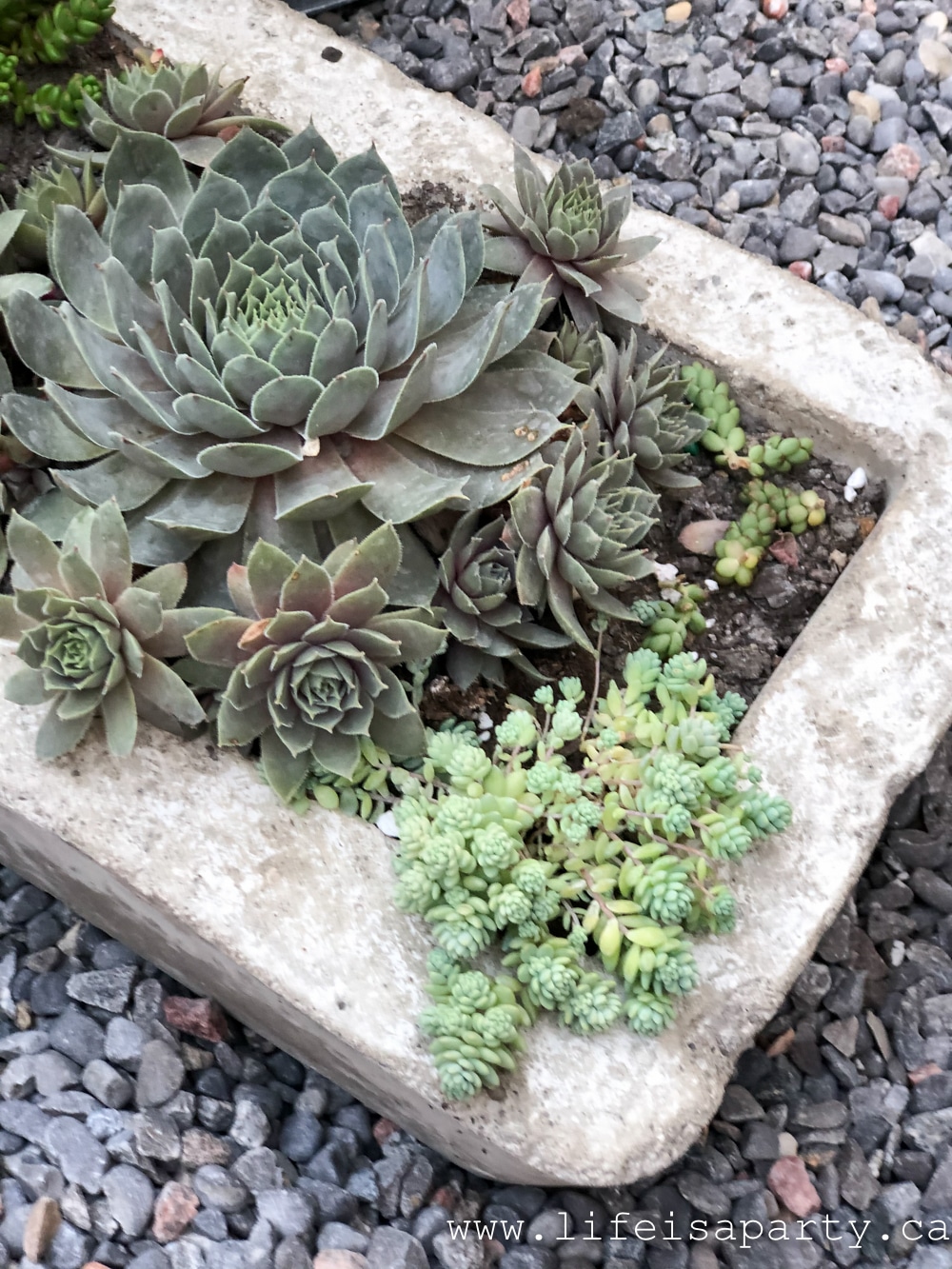
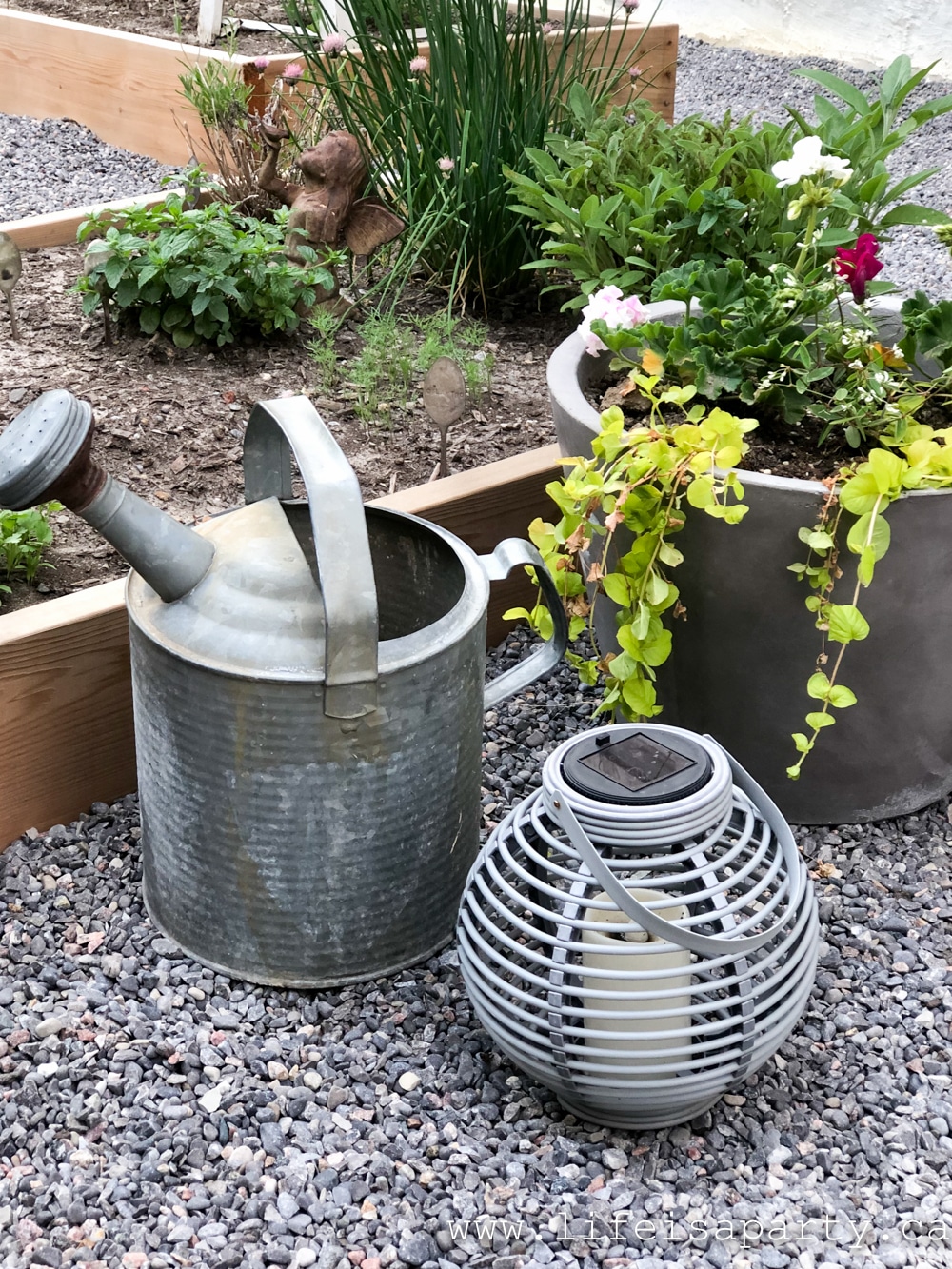

Perennial Beds
Unlike a plain vegetable garden, a potager garden often includes perennial flower beds too. Around the gate entrance there are roses on the arbor, and flower beds. The area here is mostly shady, so it was fun to fill it up with lots of types of plants that love shade. This area especially has the freestyle flow of a cottage garden that I love, and is often a part of potager design, with its ground beds that contrast the raised beds. We've tried to place taller plants at the back, shorter plants at the front. Although there's not much space, I've tried to squeeze in different plants that bloom through the whole season to create interest all summer.
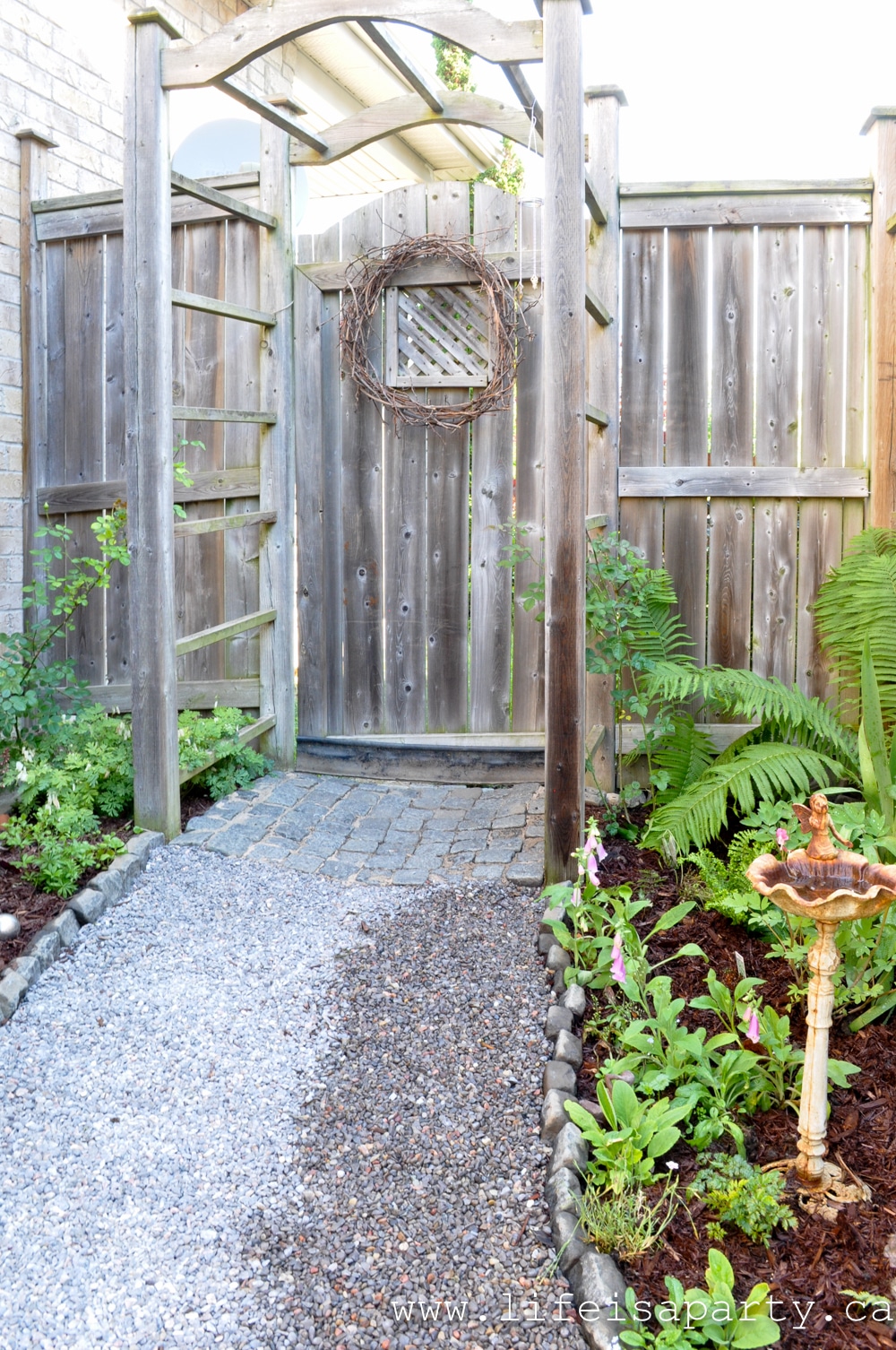
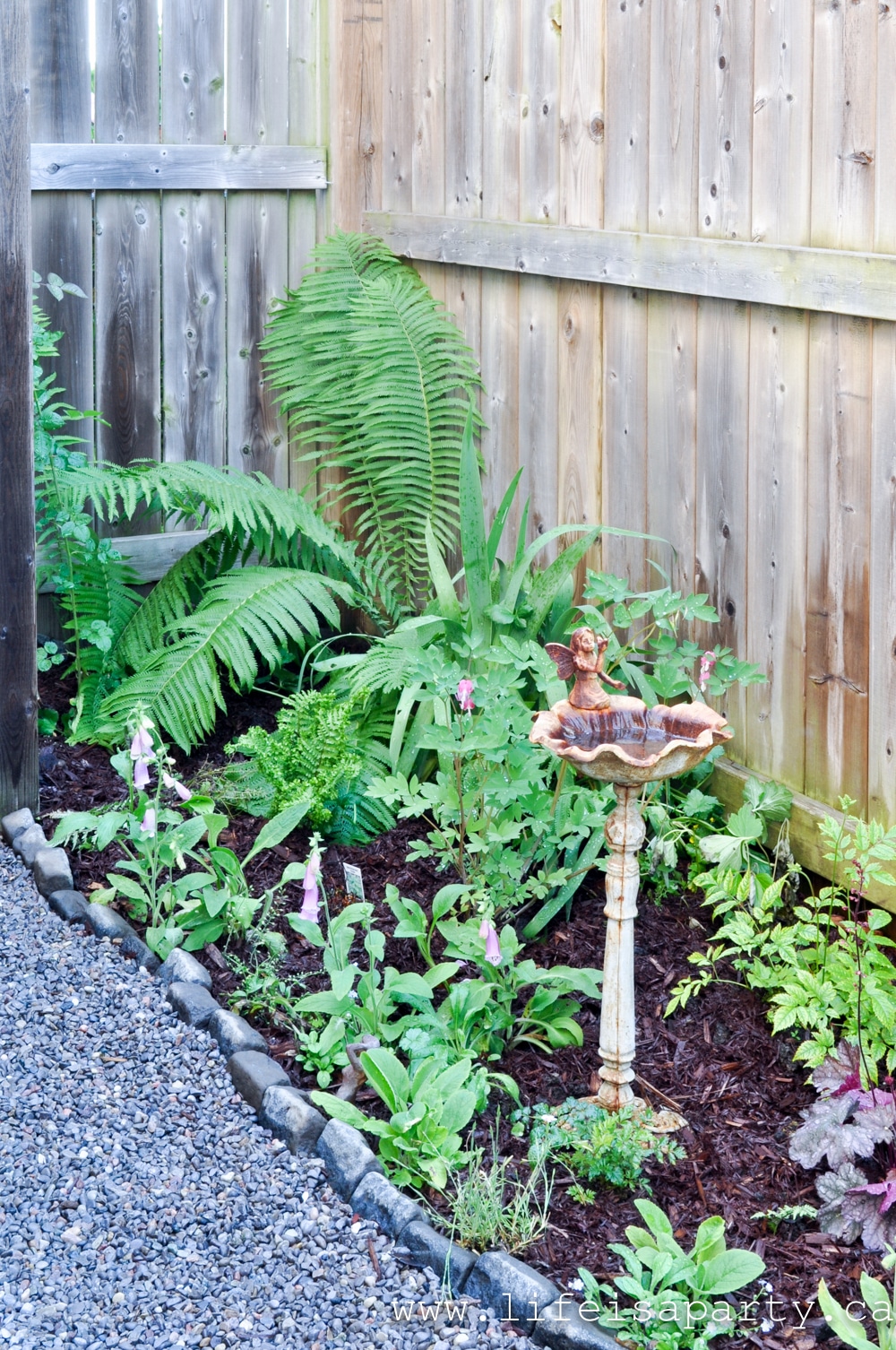
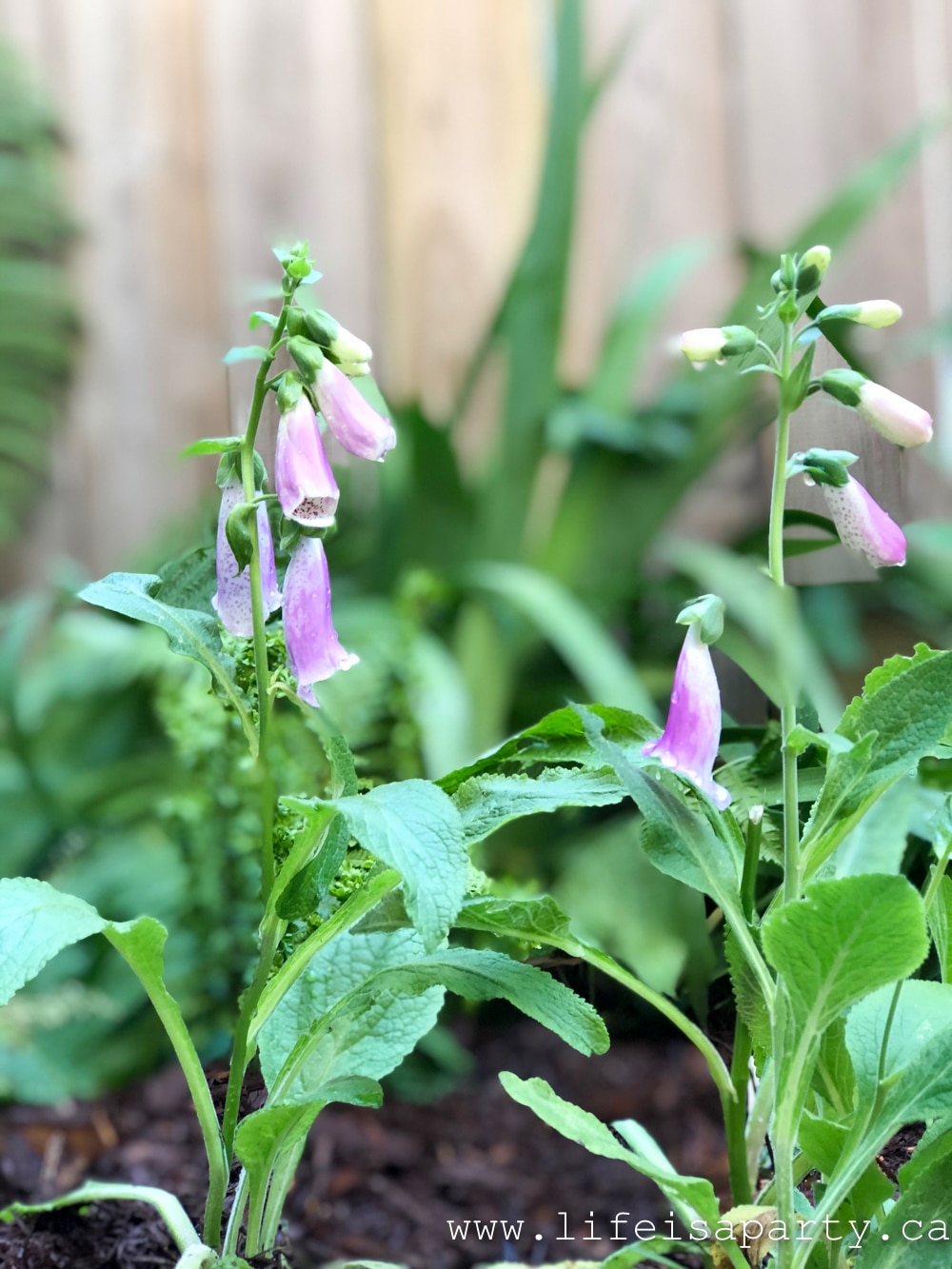
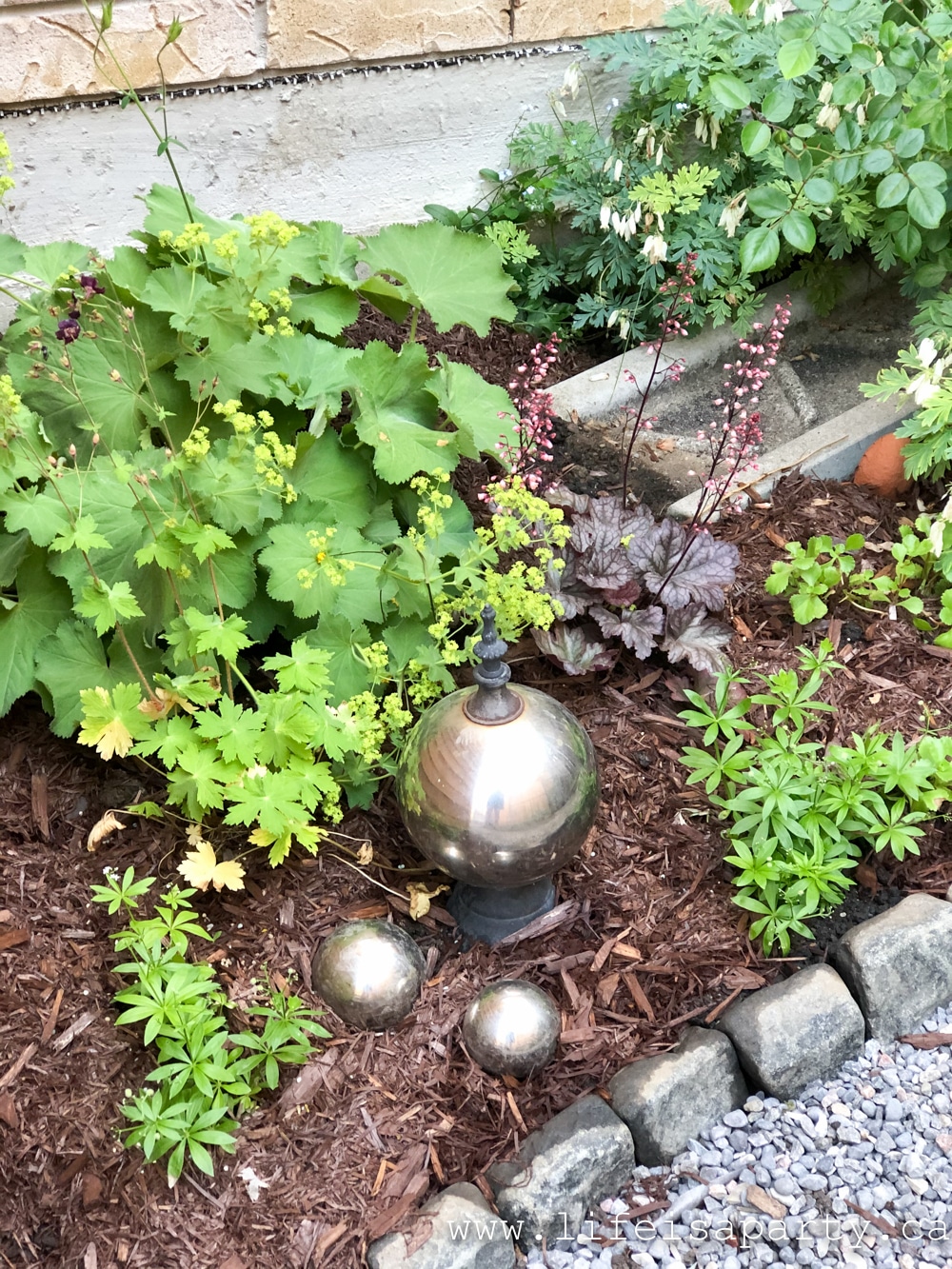
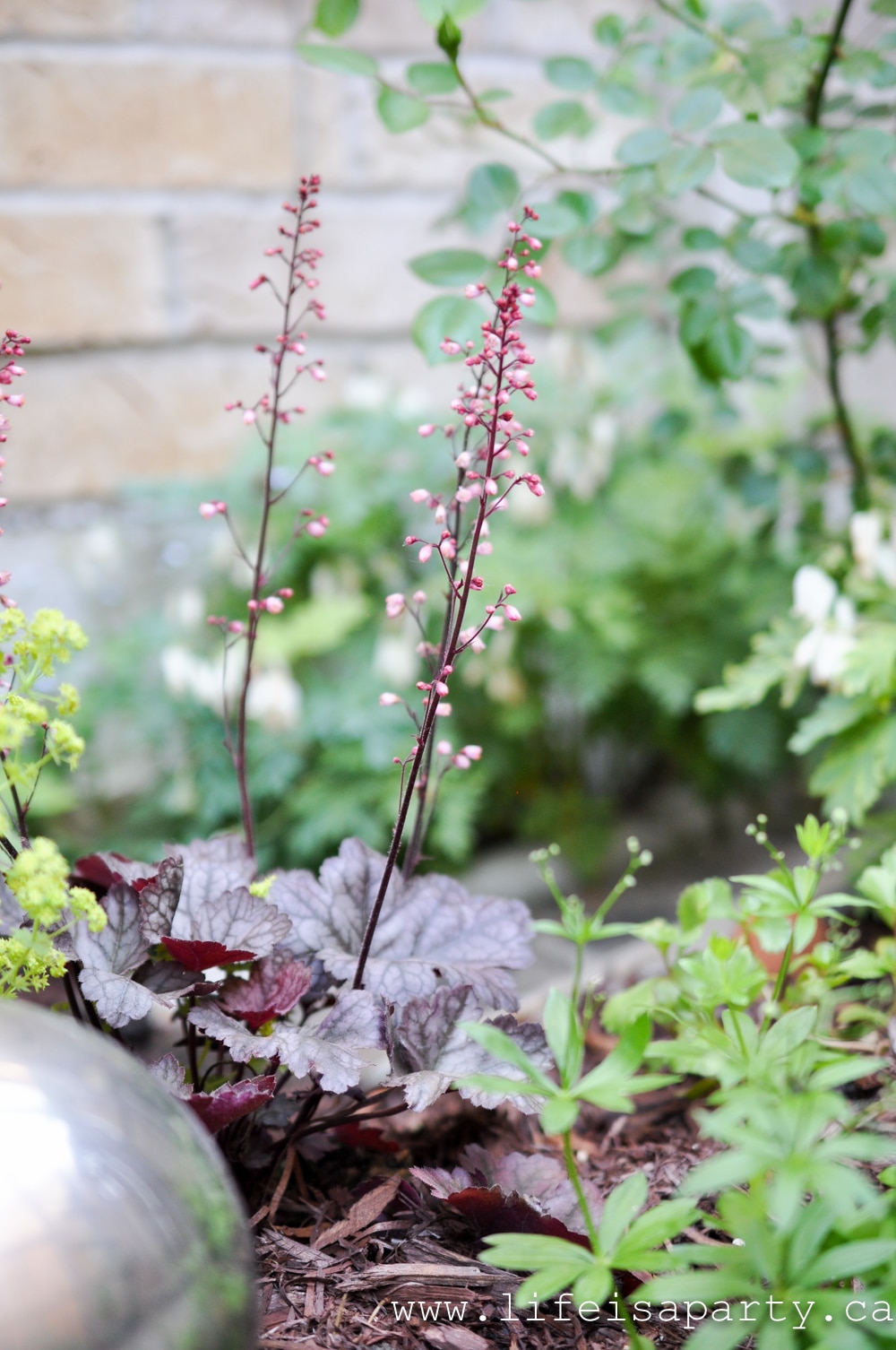
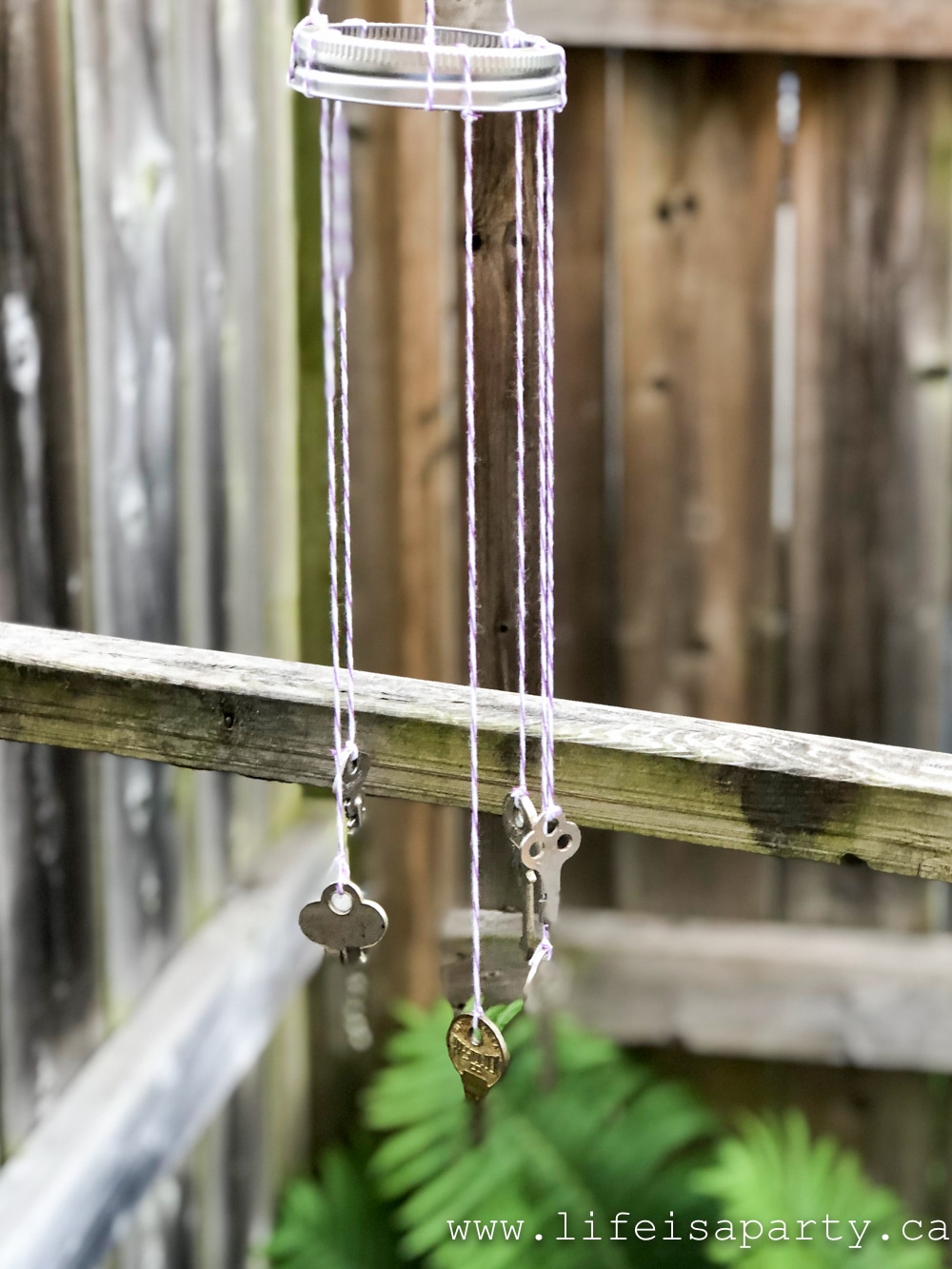
I also moved a clematis that was in the space, but in the wrong spot. Potager gardens consider garden design, colour, texture and placement of plant varieties. They also often take advantage of vertical space. We're looking forward to the climbing roses growing up and over the arbor, the clematis on the trellis, and some sweets peas climbing on the white garden trellis in the raised bed with flowers as vertical accents.
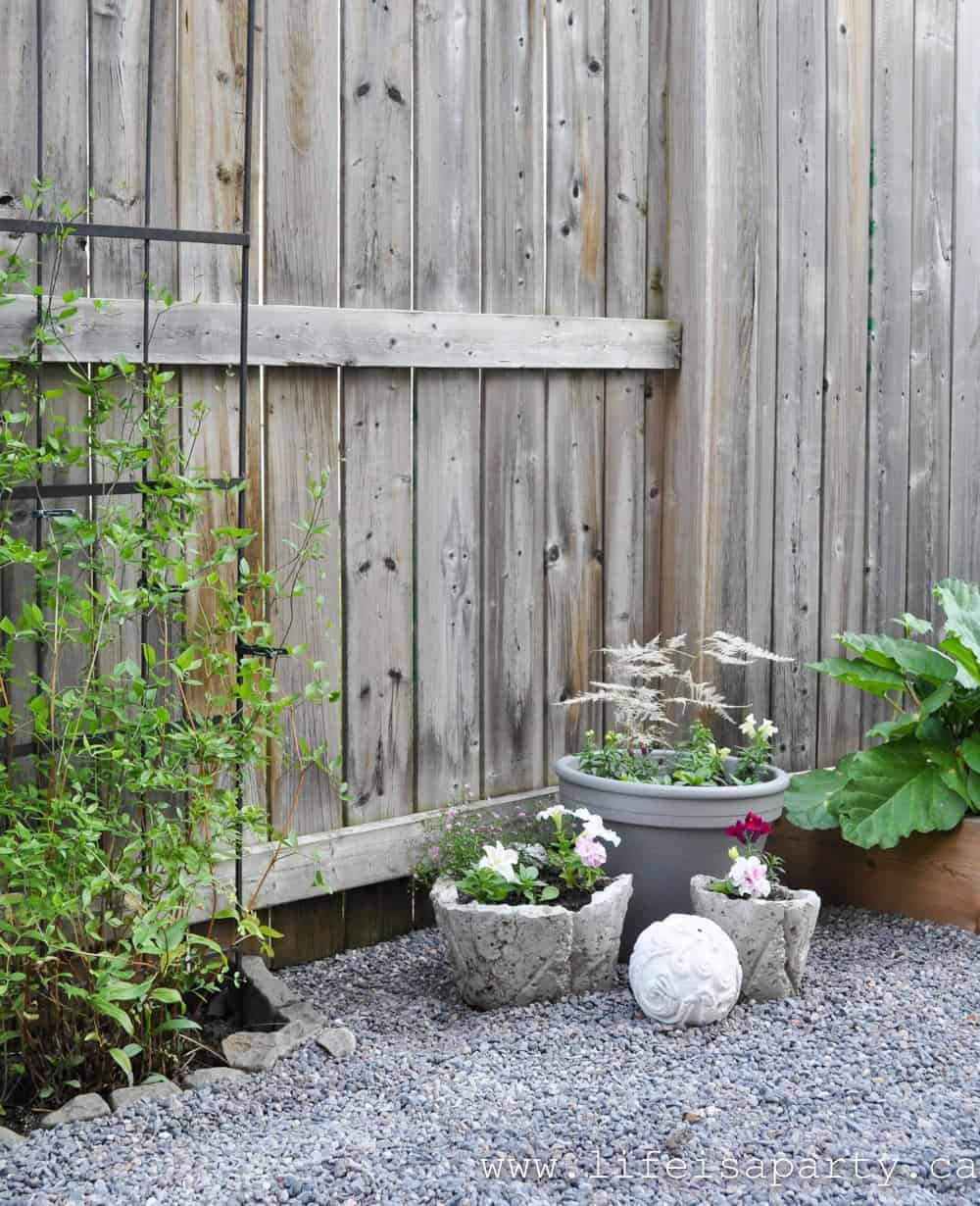
Beautiful and Functional
Sometimes after completing a big project that's taken a real investment of time, money and energy you feel a little regret or disappointment. Not this time. I love it. It's created a beautiful space for us to enjoy. It seems like every morning I'm out there in my pjs with my coffee checking on what's grown, pulling a few weeds, and enjoying it.
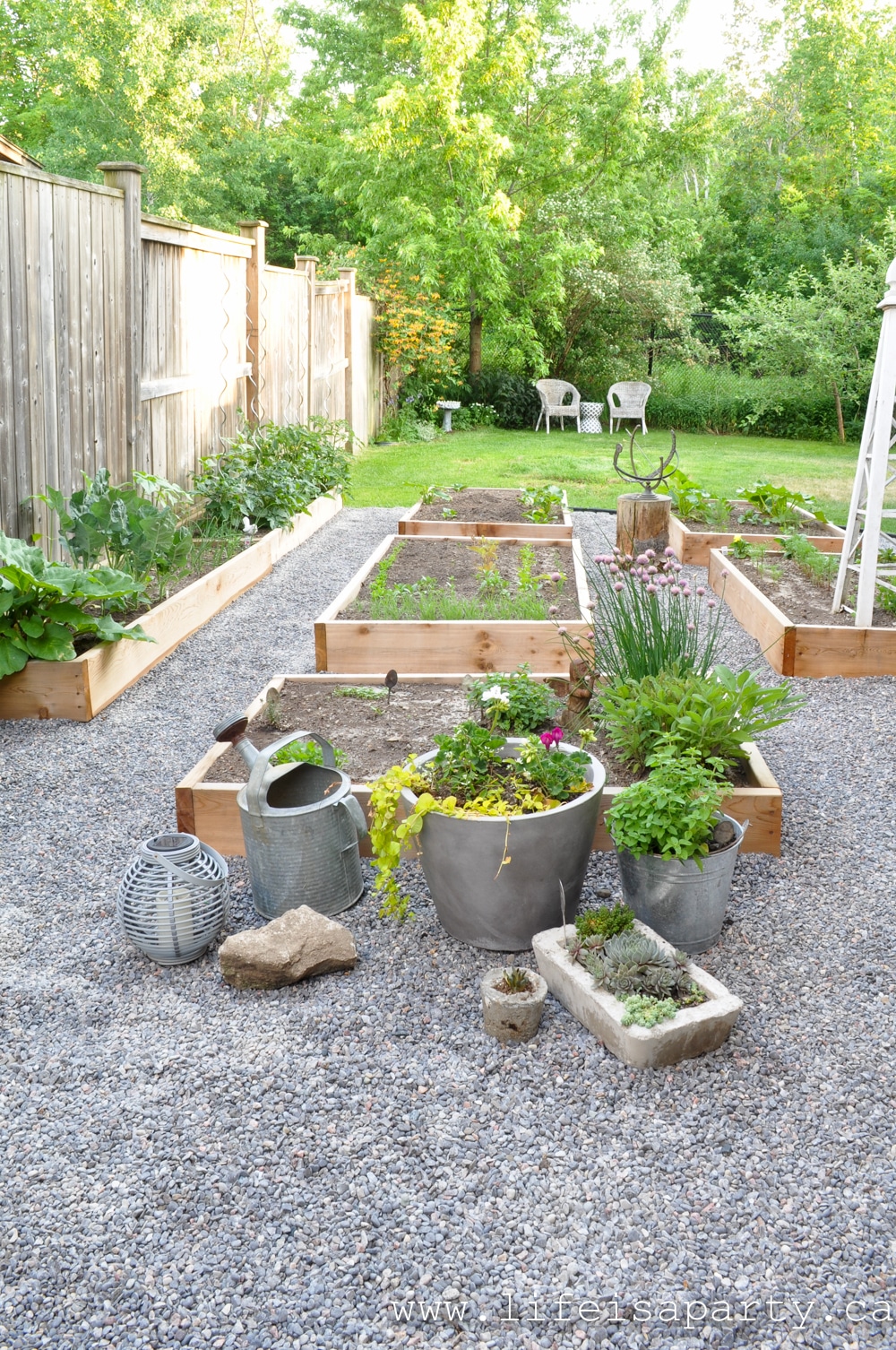
The seating area is nice and shady around 5 pm and I have been dreaming of sitting there with a glass of wine with my husband before dinner. It was too hot to christen it this weekend, but I'm sure that in the next little while I'll make my little dream become a reality.
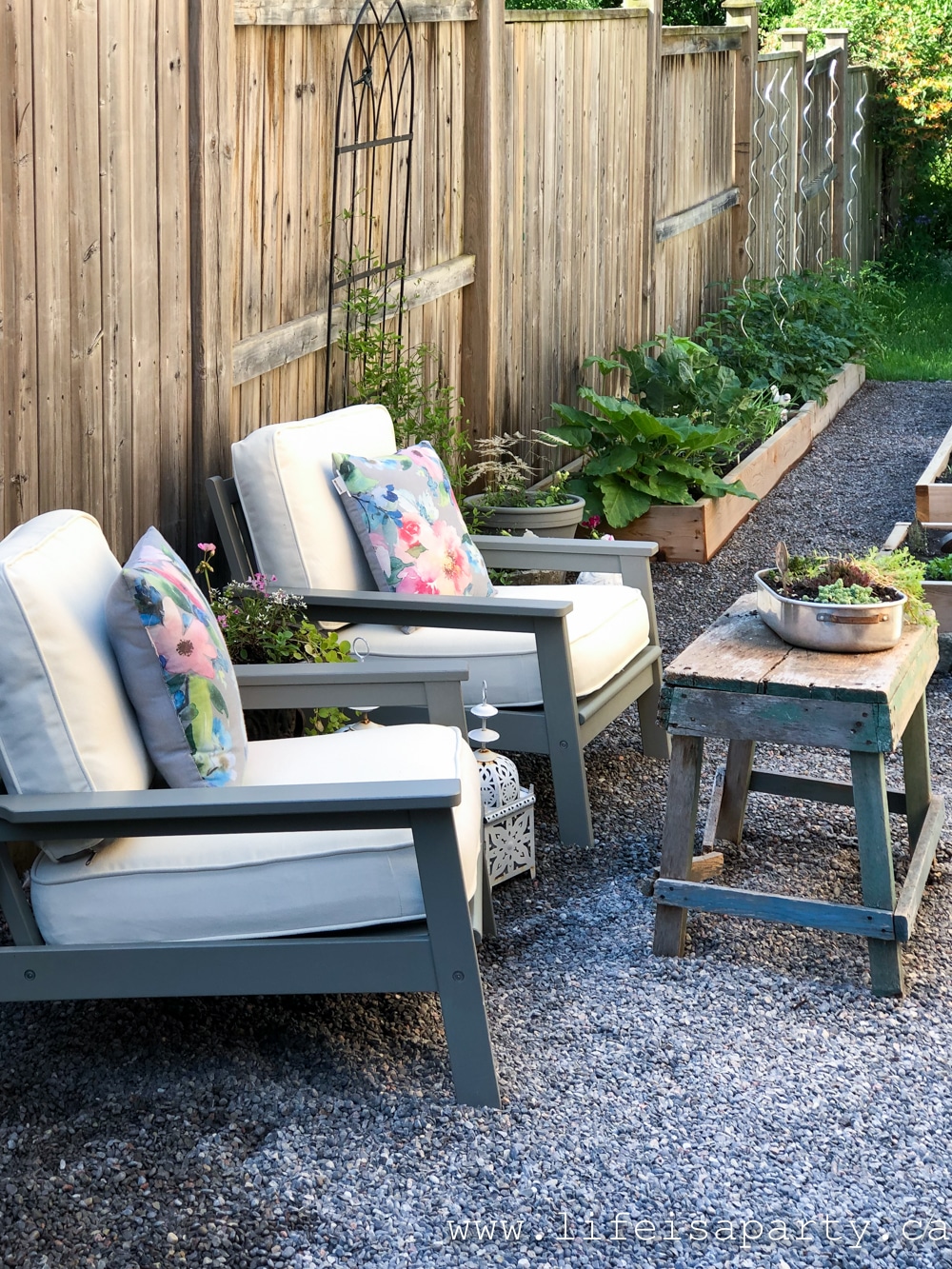
The she shed is also the perfect spot to do a little work at the desk. My girls have already been using it. During covid especially, it's nice to have a little extra quiet spot to work. When it cools off a little in the early fall, it will be the perfect spot to get work done.
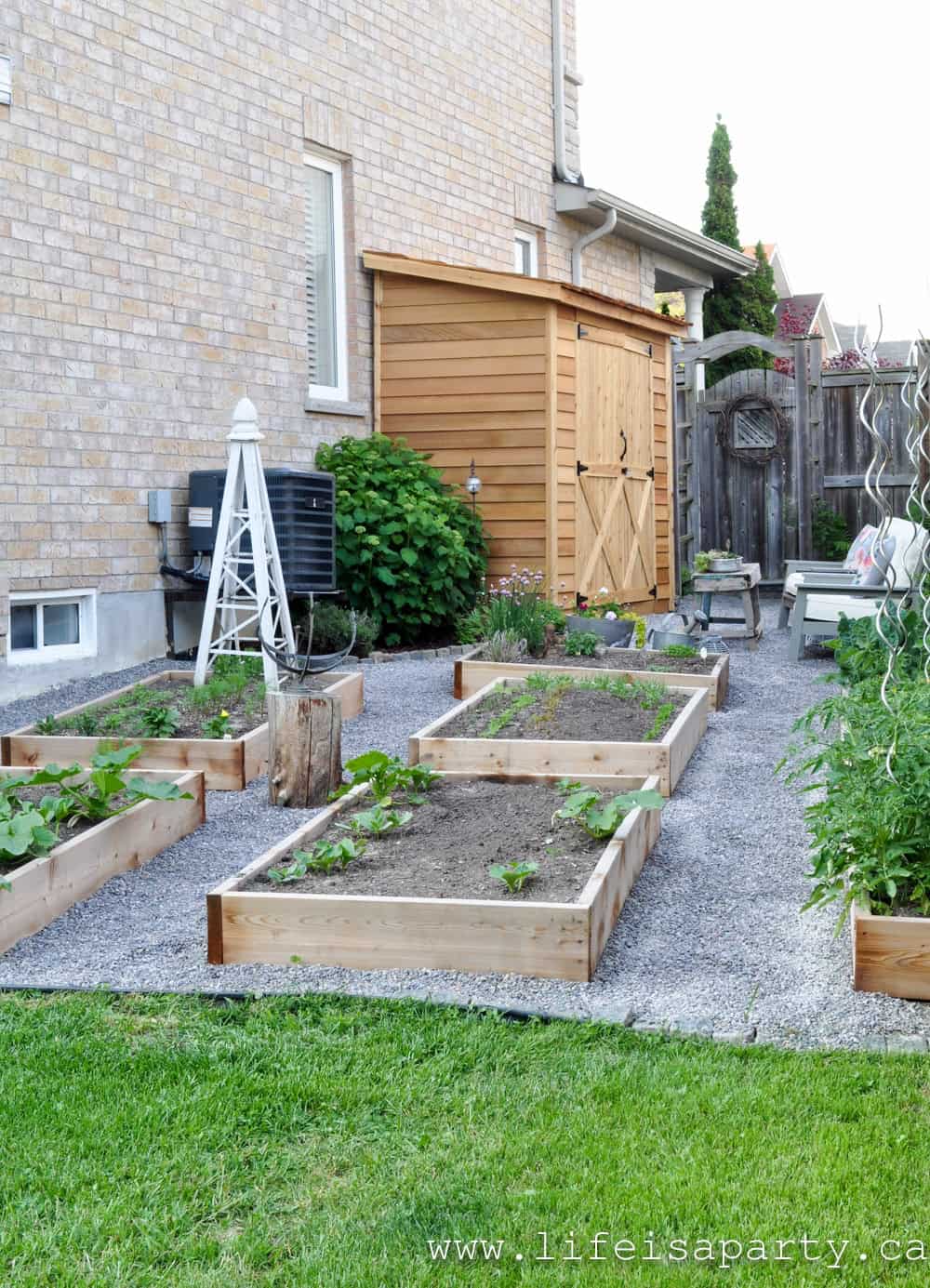
More Inspiration
You might also like our Black and White Garden here.
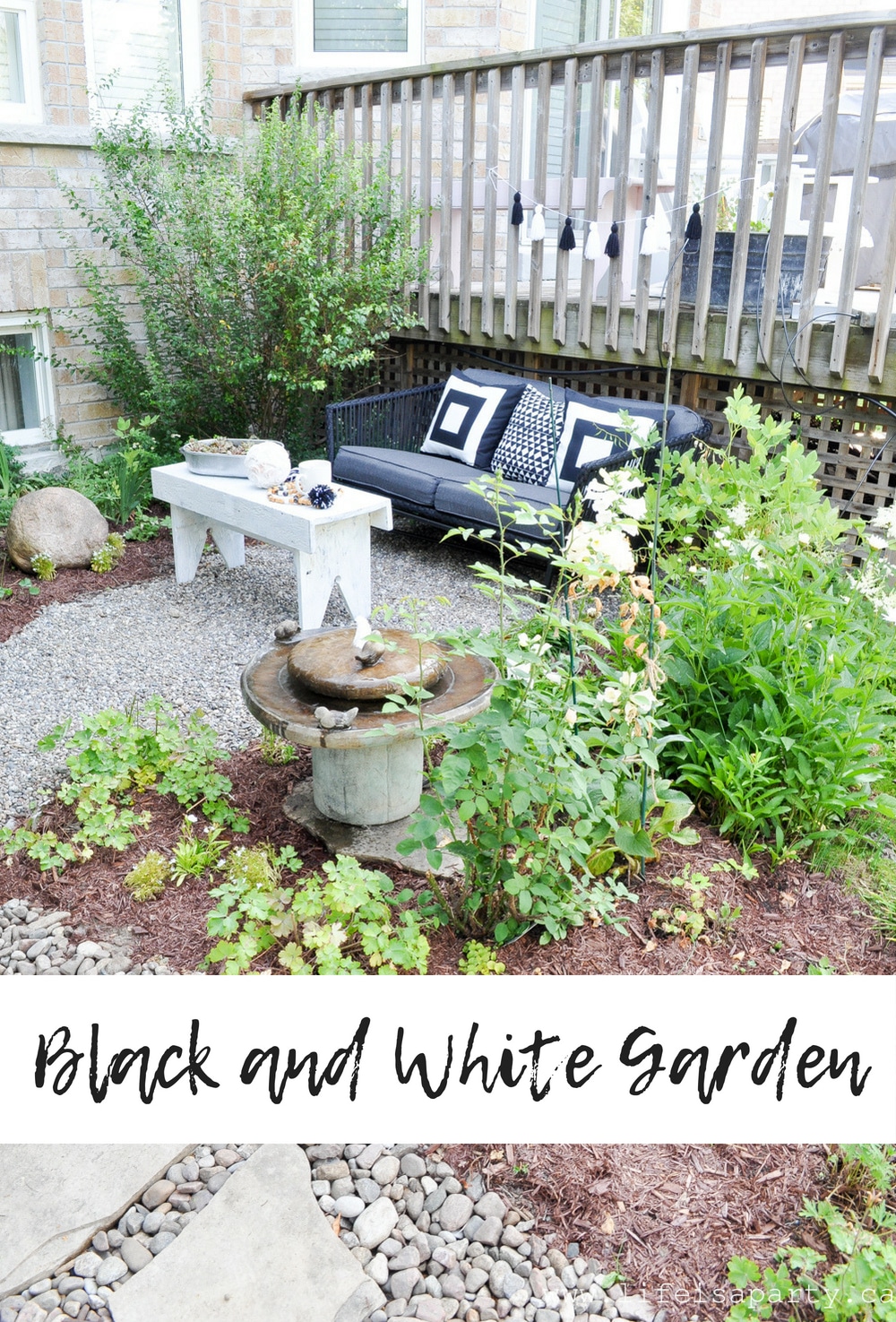
Also check out our Teacup Fairy Garden here.
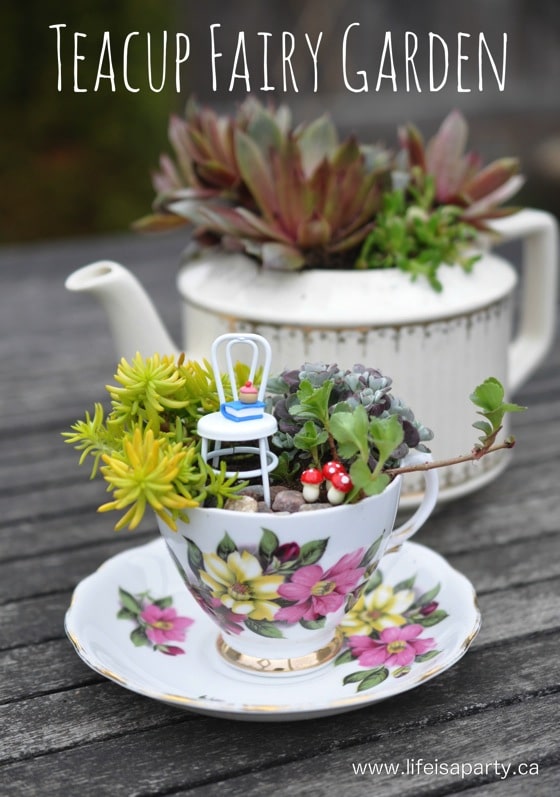
You might also enjoy Stamped Spoon Garden Markers here.
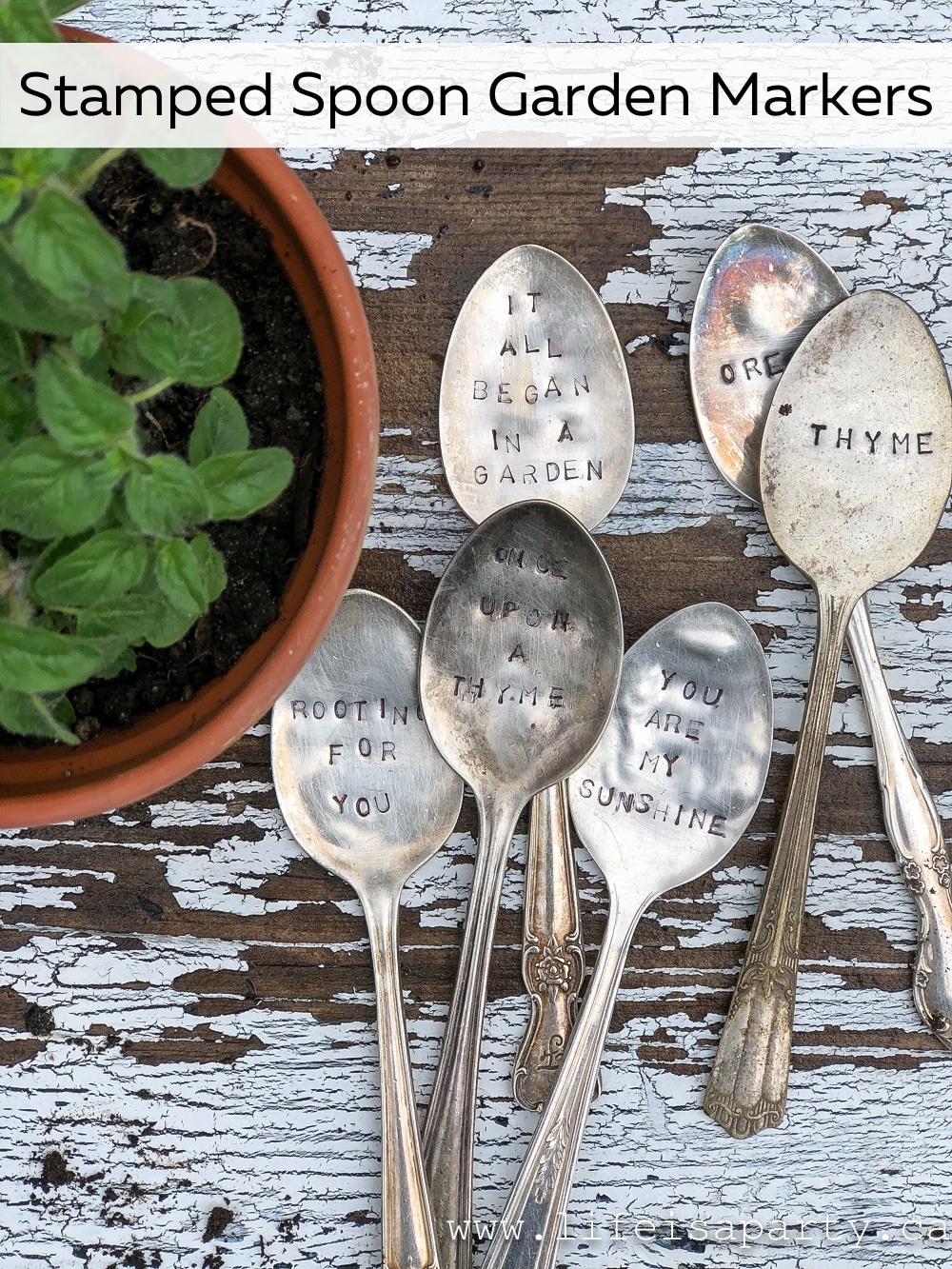





Danielle says
I love your sweet garden!
Heather says
Congratulations Dannyelle Nicolle! You and your family created such a beautiful space in your yard, it is hard to believe it is the same space.
Just a word on the pumpkins, they are very promiscuous, so if you are wanting to have different types you really need to have them in different areas otherwise they cross pollinate and become very generic. Ask me how I know.
Kind regards
Heather
Lory says
What an absolutely beautiful space you've created. Its clear you put alot of thought and effort into it and it looks perfect.
Jenn says
What a beautiful space! I've always wanted to do this in our yard. Hope you get a great crop!
Cassie Bustamante says
WOW! I miss my garden at my old house! We haven't yet had the resources to totally redo our weeded jungle of a backyard, but this is GOALS!